Review of Angela Watson’s 40 Hour Teacher Workweek Club
This blog post contains Amazon affiliate links. As an Amazon Associate, I earn a small commission from qualifying purchases.
A year ago, I decided to admit that I needed help with balancing my home/work life. Teaching is hard. Not letting teaching take control over your entire life is even harder. So, when the opportunity to join Angela Watson’s 40 Hour Teacher Workweek presented itself, I jumped at the chance.

You may be reading this and thinking that this doesn’t sound right. I fear that my blog and twitter feed sometimes give the impression that I’ve got this whole thing figured out. After all, I regularly post photos of my overly-decorated classroom and activities that I created myself. That’s the stuff that I want you to see. You rarely get a glimpse of the fact that there are days I dreaded going to work. You didn’t see the lessons I taught that were thrown together at the last moment. You didn’t witness my mad dash to the copy machine between classes to grab materials for the next class.
A year ago, I was a mess. I had just finished my most stressful year of teaching yet. It was my first time ever having four preps. It was awful, and I would never wish that on anyone. I know there are teachers out there who have six preps, and I think you deserve all the credit in the world. I couldn’t do it. When I was feeling my worst, my colleagues did something unthinkable. They named me as the best. I was named district teacher of the year, but I didn’t feel like I deserved it. This was when I knew something had to change.
My teacher resume looked great on paper. In 2017, I was named one of twelve finalists for Oklahoma Teacher of the Year. I didn’t win in the end, but I met some amazing teachers in the process. In 2015, NPR published a feature story about my innovative approach to teaching math.
My successful math teaching blog (the one you’re reading right now) has had over 10 million page views since 2011. I’ve presented at state and national conferences. On paper, I looked like I had it all. Inside, I felt like I was falling apart. I was dreading going to school. I was feeling ineffective as a teacher. I was disorganized. I felt like I was spending all of my free time thinking about school things without ever feeling on top of things.
I was already familiar with Angela Watson from her Truth for Teachers podcast which was recommended to me a couple of years ago on Twitter. I loved her positive outlook on teaching and upbeat attitude. I will admit that her approach is not for everyone. My husband (also a math teacher) ended up listening to many of Angela’s podcasts because he was in the same room as me as I was listening. He did not find them to be as inspiring as I did. So, I would recommend checking out her podcasts before deciding to jump into the 40 Hour Teacher Workweek Club just to make sure they are for you.
I am a totally different teacher now than in years past. I am organized. I am focused. I don’t spend all my waking hours thinking about school. I have priorities, and I am using them to limit what I
spend time on. I make time for the things that bring me joy and increase my energy. And, I’m working to limit the things that zap my energy. My classroom is running smoother than ever before, and my students are carrying more of the burden of keeping our class running.
I still have stressful days, but Angela’s List Making System makes sure I always know what needs to be done next. My lessons are being prepared far sooner than they ever have been before in my career. And, when they are sometimes still thrown together at the last minute, I’m learning to give myself grace.
My work/life balance isn’t perfect, but it’s 100 times better than last year. I am writing lesson plans consistently for the first time ever in my teaching career. I spend more evenings at home relaxing
than I do planning lessons. And, I am more organized than I have ever been before. When coworkers see my lesson planning binders, they are amazed.
So, what do you get if you join this club?
1.Advice. I love that the tips I have learned in this club can be implemented tomorrow instead of having to wait until the next school year rolls around.
2. Encouragement. Angela is one of the most encouraging people I have ever heard talk about teaching. She always has a positive outlook. I love that she consistently reminds me that we all grow and improve inconsistently. Setbacks are okay. For example, if I’m currently a few weeks behind on club material (each week you will get a new PDF packed with advice along with an audio version of the same material), that’s okay. Once you join the club, you get to keep your membership forever. As long as I’m improving, that’s exactly where I need to be.
3. Camaraderie. There is a very supportive facebook community for participants. Everyone in the facebook group is very friendly, and it’s an awesome place to get feedback on ideas. I’ve asked several questions and received very helpful responses.
4.Support. You are constantly reminded that you are not doing this alone. You are not the only teacher who feels tired, overworked, overwhelmed, and stressed.
5. Free Resources. Almost every week, there are free printable resources that you can use to stay organized. Some weeks, there are even printable activities that you can use in your classroom.
6. So Much More. Basically, you will get everything you put into this club back out plus some!
Could you seek all of this out on your own for free? Probably, but what teacher has time for that? Angela has packaged it all up so nicely that it is actually manageable to tackle alongside your normal teaching responsibilities. It’s created by a teacher, so you know that the advice will work for teachers. I’ve read many a productivity book where I spend half my time thinking “Yeah, that would be great advice if I worked in an office, but I’m a teacher.” This is written by a teacher for teachers, and that’s the type of product I love to support.
Each month has a different focus. My favorite months were July, August, October, and April. July gave me a lot of food for thought when it came to setting up my classroom. It showed me what areas I needed to focus on at the beginning. It turned out that in years past, I had spent a majority of my time focusing on things that turned out to be not so important in relation to the rest of the year. August’s lessons taught me to create systems that would save me time in the long run. In October, I learned how to organize and prioritize my tasks. I learned a lot about why I procrastinate and how to combat it. I’ve probably re-listened to the October audio lessons at least three times. They are SO good. April focused on work/life balance, and I can definitely stand to learn more about that. Some months will be more applicable to you than others, and that’s okay.

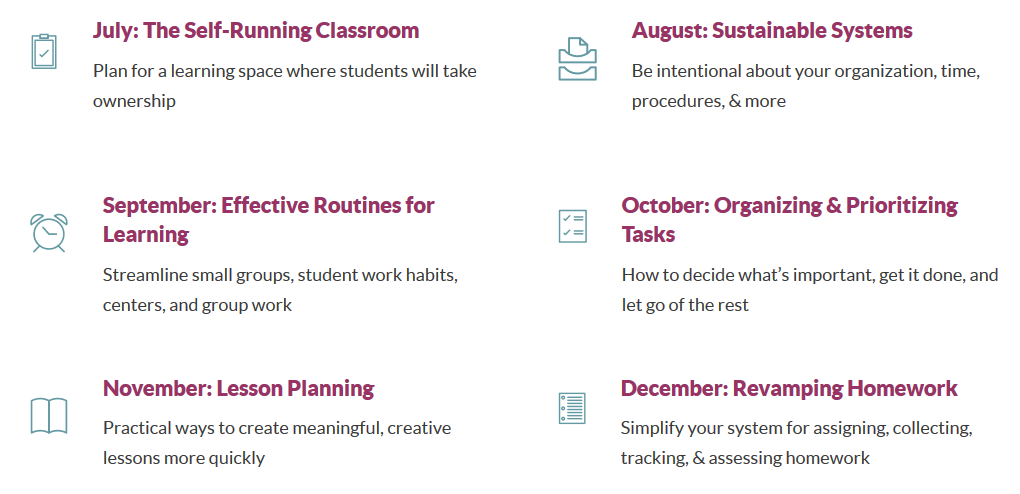
If you are interested in joining Angela’s club and learning how to achieve work life balance by working smarter instead of harder, you need to act fast. New club memberships will only be accepted until July 18th. That means you have two weeks to decide if you’re ready to make yourself a priority this school year. If you don’t act soon, you will have to wait until January when the club reopens. If you do decide to join, please list me as referring you. You’ll need to enter my name (Sarah Carter) and my email address, mathequalslove@gmail.com when you sign up.
Okay. Let’s get on to the fun part. What have I learned since joining the club?
I learned that I don’t have to create brand new decorations for my classroom every single year. It is okay to reuse the same decorations. This took so much pressure off me as I was preparing my classroom for this past school year. I focused on creating sustainable routines instead of having the newest, cutest room decorations.
I adopted new strategies for managing my classroom. One of my favorite new strategies is the humble timer. I ordered a multi-pack of timers from Amazon for my husband and I to share. I use these ALL THE TIME. I set time limits to keep my students on task. You have two minutes to cut out your notes and glue them in before we move on. I used to use the SMART Notebook timer for this purpose until our software got updated and the timer became one hundred times more difficult to use. When students come in to serve lunch detention, I set a timer for fifteen minutes and write their name above the timer. Then, there is no arguing about whether their time is up or not. I originally planned to use them to time students when they left class, but I was not successful in keeping up with that one.
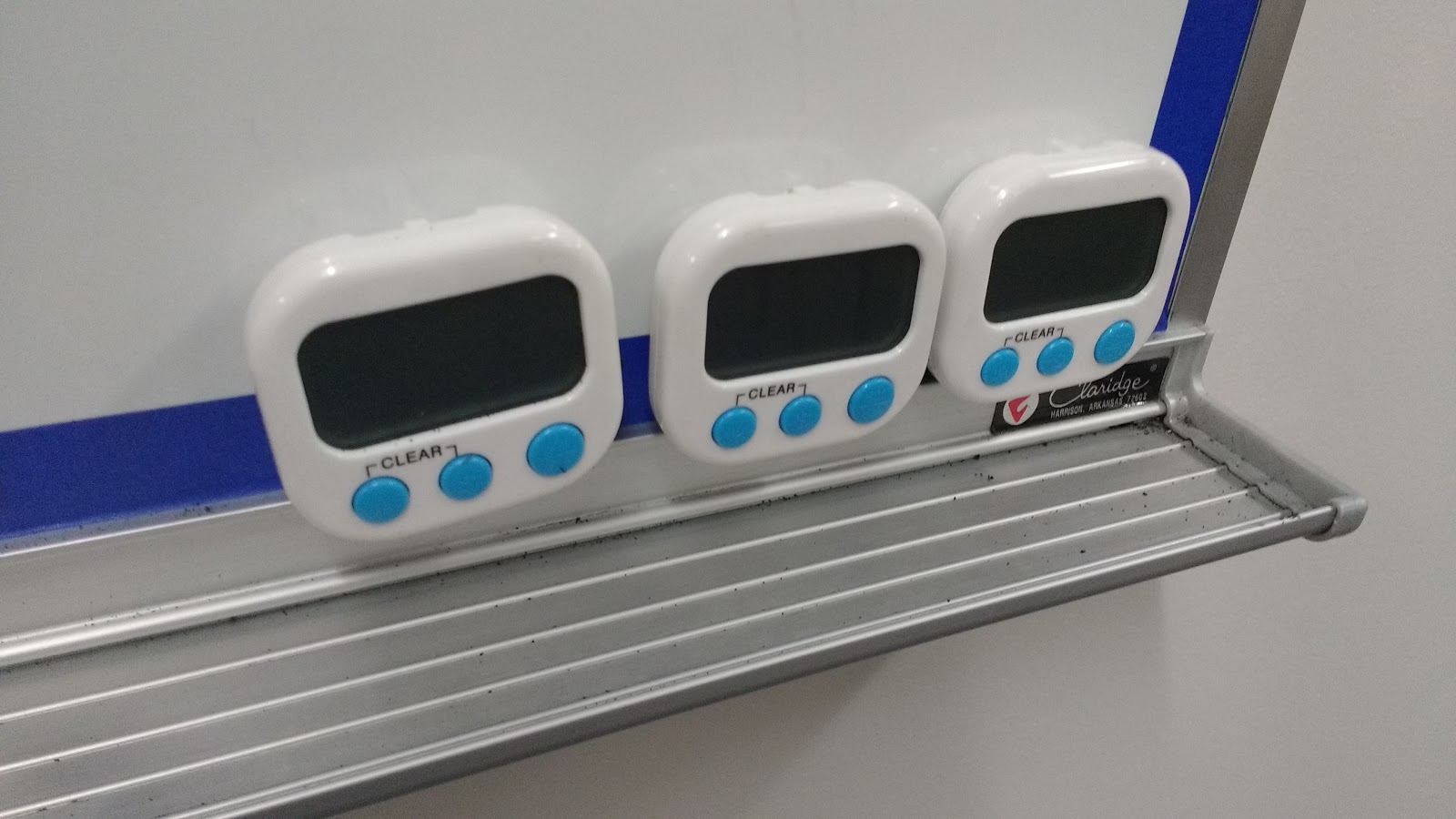
I embraced classroom jobs for the first time. I had always written these off as too elementary, but it turns out high school students still love having jobs. In the photo below, you will see where I write the date each day. At least, that’s where I used to write the date each day. I start off each year strong with date writing. But, then I get busy and skip a day. Or two days. Or two months. Yes, that happened last year. In April, the date on the board still read February. This year, one of my students has the job to write the date each day as a math problem. The date gets written, and I don’t have to stress about it.
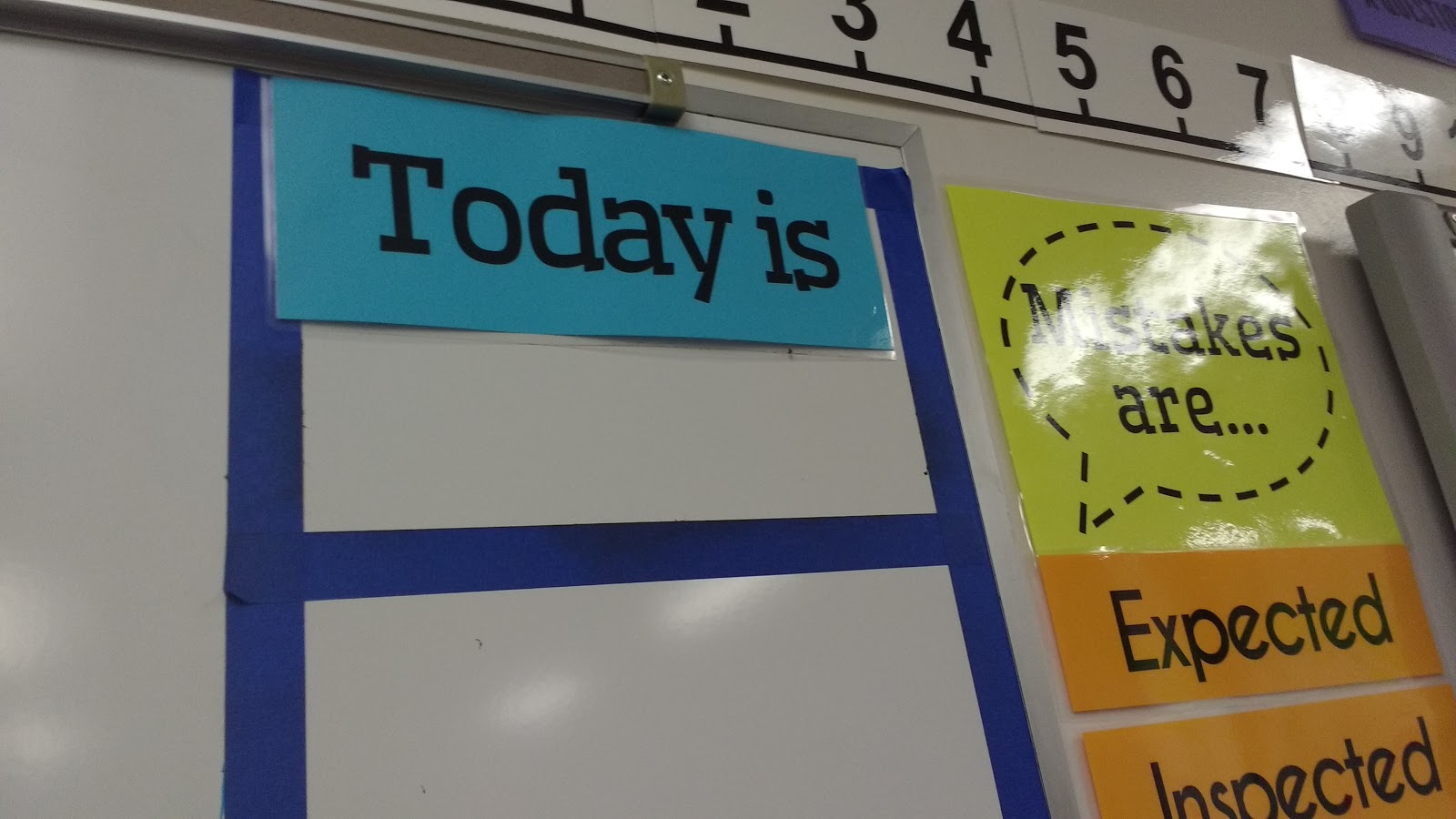
I no longer spend time watching the clock each class period. In the past, I was often caught off guard when the bell rang. This year, our intercom and bell system has been broken. We have had to watch the clock to know when to release students. I installed the Musical Timer Extension for Chrome (NO LONGER AVAILABLE). I now have my computer programmed to start playing Vitamin String Quartet on Pandora two minutes before each class period is over. Students are not to start packing up and cleaning up until the music starts playing. When the music does start playing, another classroom job that I mentioned earlier kicks in. My “Clean-Up Captains” in each class start going around the classroom to tell their peers what trash needs to be picked up and which supplies still need to be put away. My clean-up captains are the last to leave each day because they are responsible for making sure the room is clean and tidy for the next class. My room stayed cleaner this year than ever before as a result.
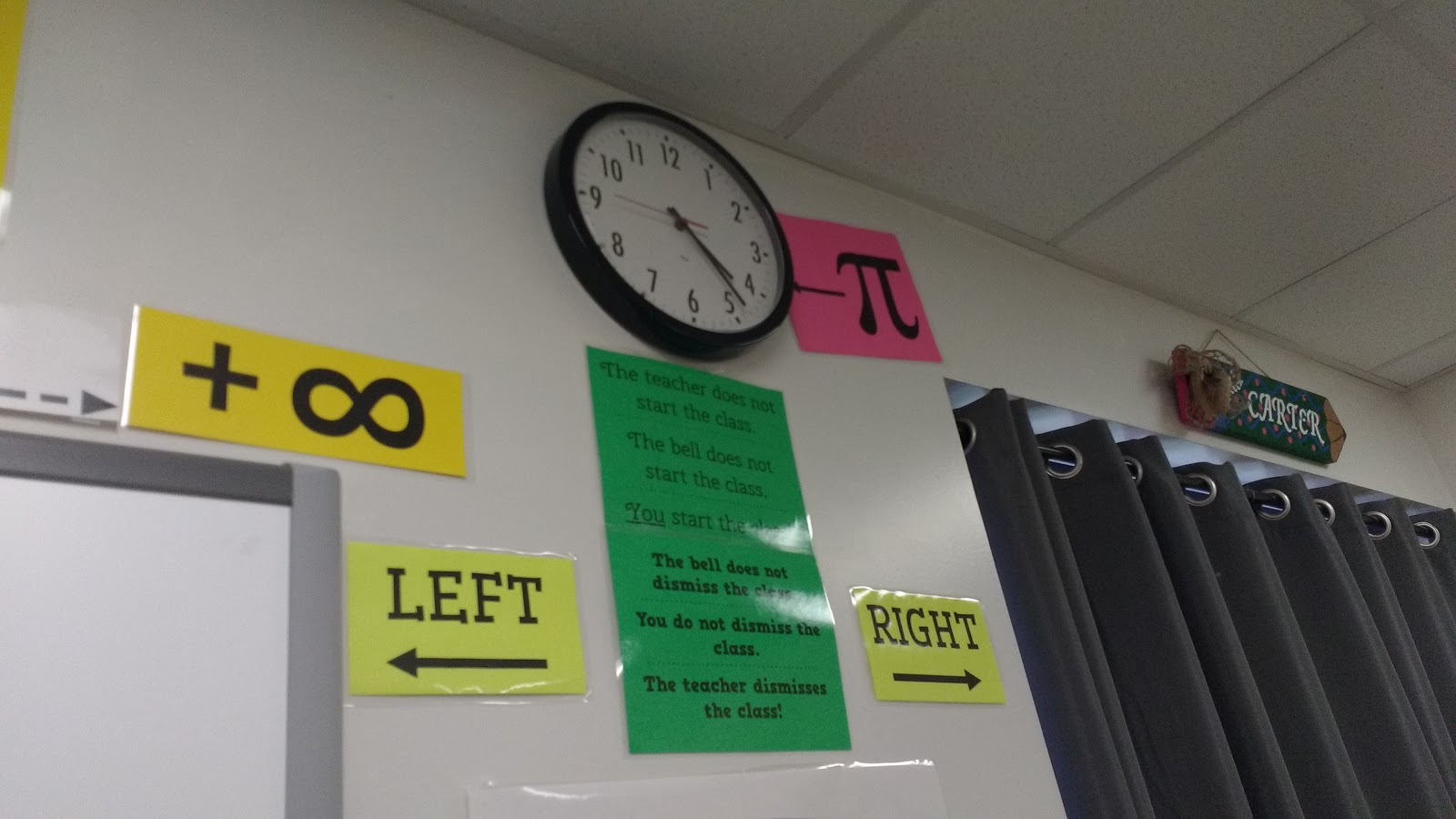
My filing system is more organized than ever. I now view my filing system as an investment for the future instead of an annoying task or waste of time.
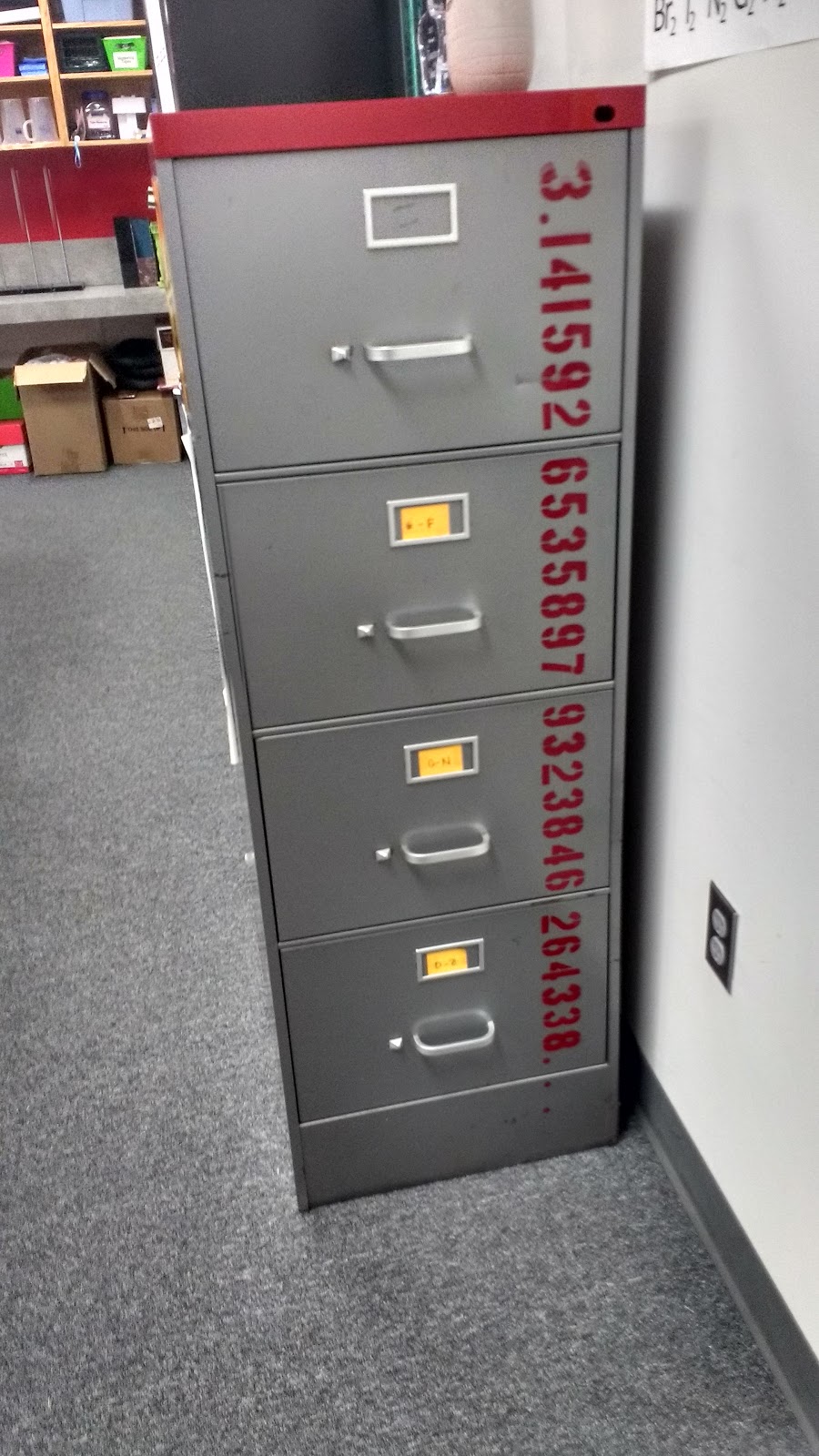
The top drawer of my filing cabinet holds colored paper that is sorted by color using hanging files.
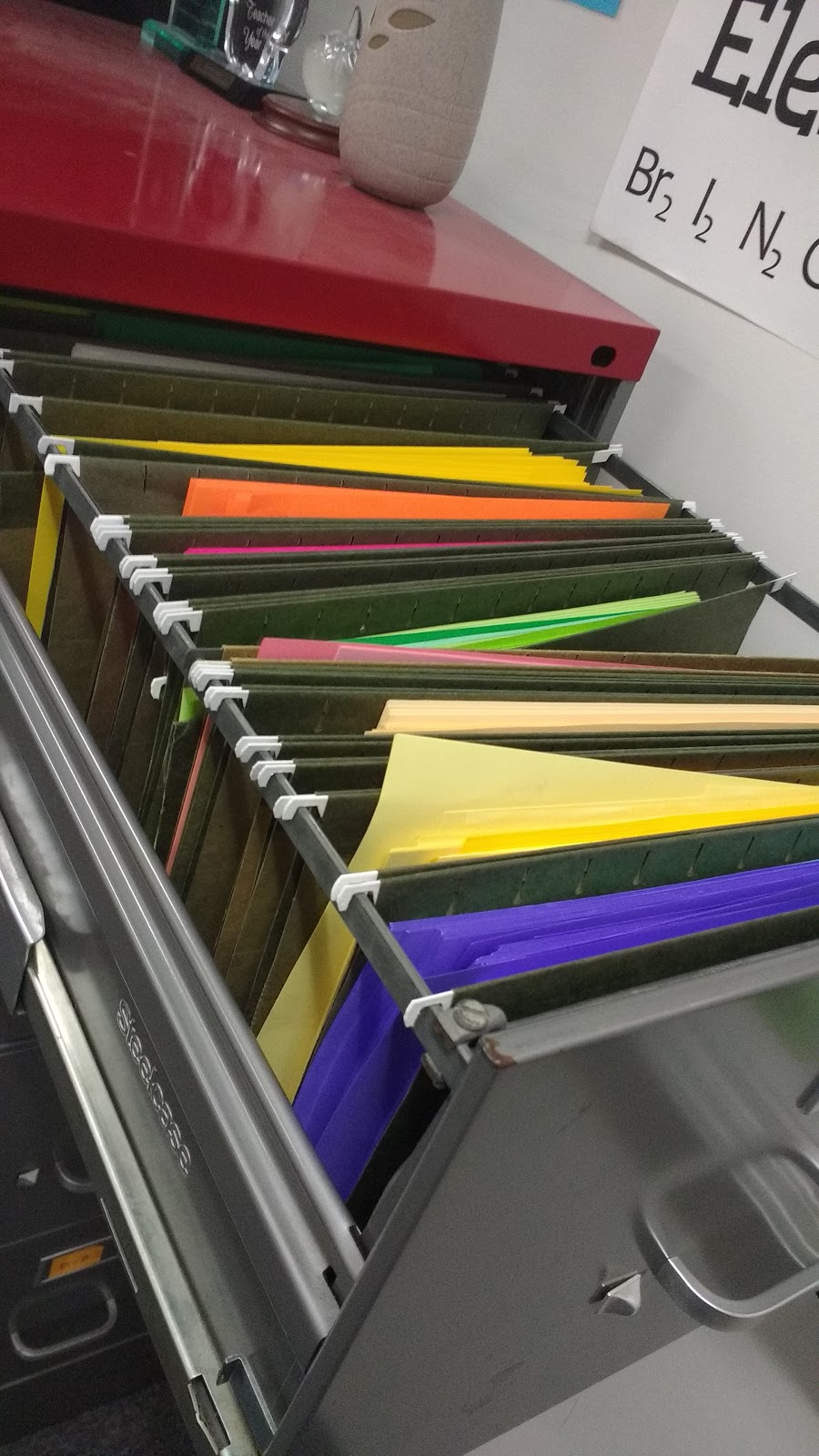
The other three drawers are labeled with which letters of the alphabet they contain.
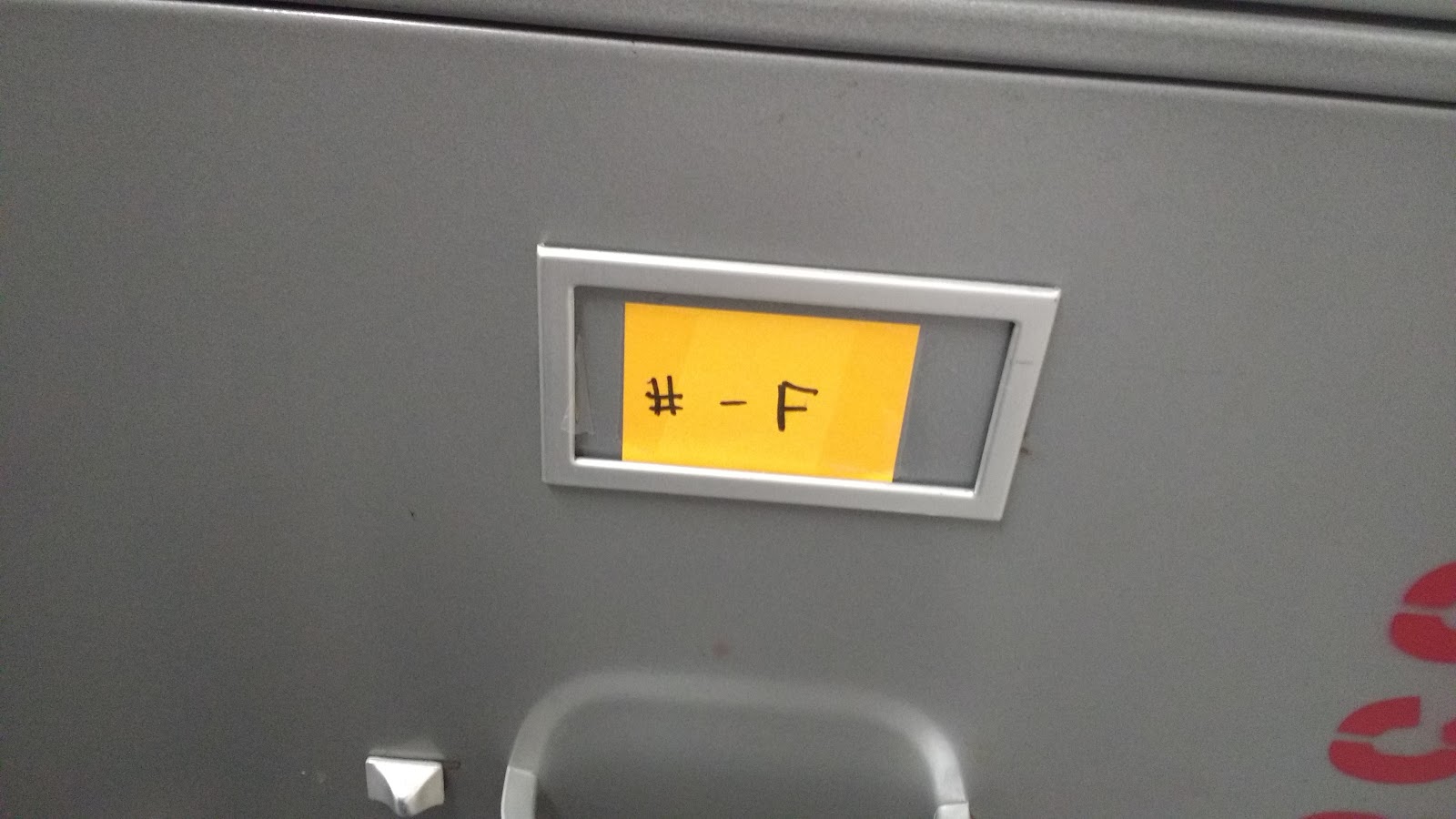
The three bottom drawers contain all of the activities I have ever used with my students. They are stored alphabetically in plastic storage pockets. These pockets are translucent and velcro shut. I have labeled the contents of each pocket in the upper left hand corner. These labels are really just super sticky post-it notes that have a complete coating of adhesive on the back. This means I can easily change out the labels.

I’m able to keep my desk cleaner (a major goal this year) by using clipboards to hold frequently used papers on the wall behind my desk. I have my “Out of Room Log,” my “Tutoring Sign-In” sheets, and my list of students who owe me detentions. I’m slowly learning that the best home for most things is NOT on my desk.
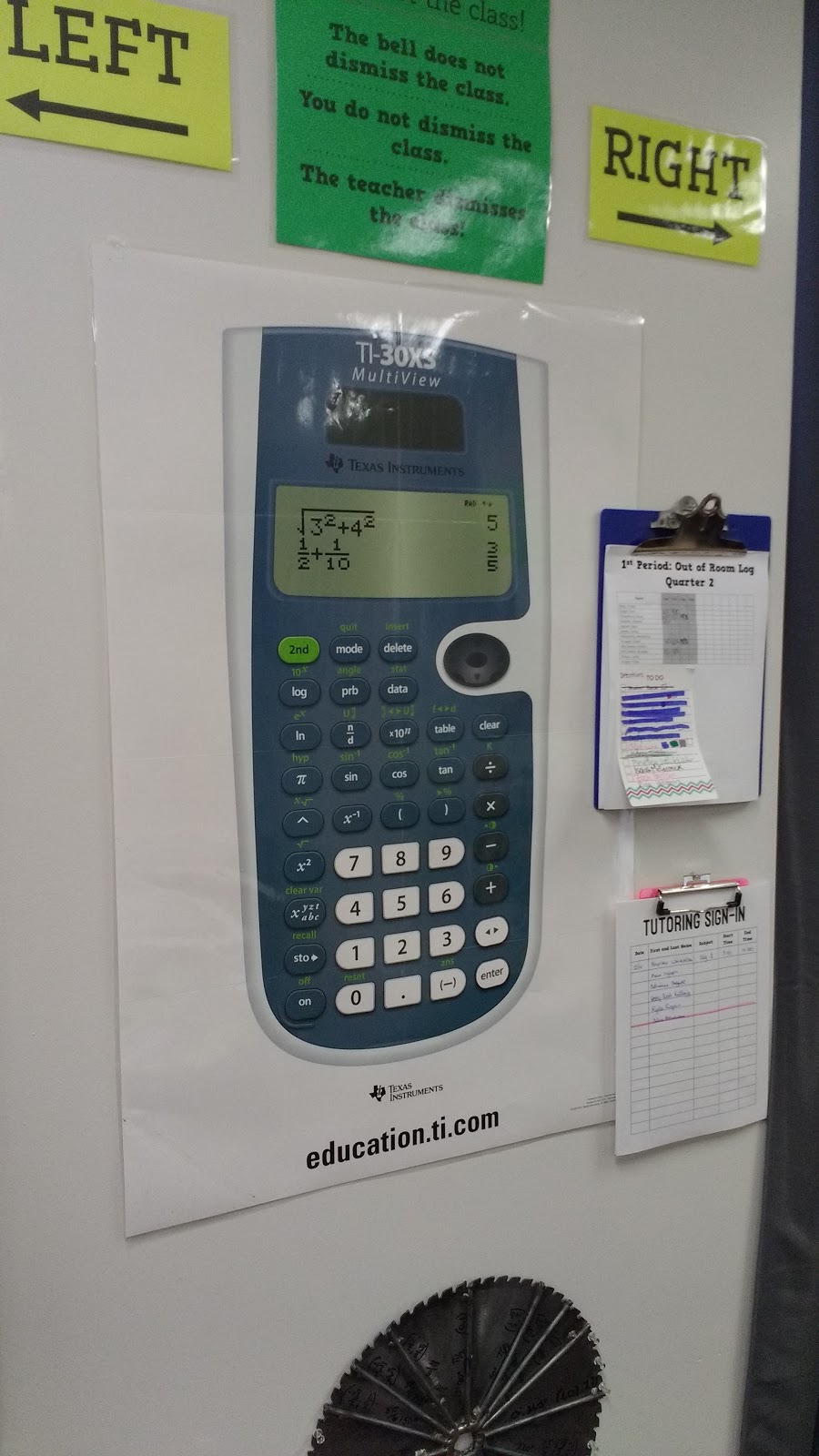
Angela Watson encouraged us this summer to spend a chunk of time looking for ways to organize our classrooms. Organizing has never been something I am especially good at. But, I took the organizing leap, and I don’t think I will ever look back. It has made my classroom a much happier place. Below, you will see the 11 x 17 activities I have created for my students over the last couple of years. Each one of them is printed on 11 x 17 cardstock. In the past, these were just stuffed in a cupboard. Now, they are labeled and easily accessible. I’m slowly learning that time spent organizing your classroom results in a feeling of incredible peace and actually ends up saving so much more time later. I no longer waste hours searching for things because I can’t remember which cabinet or drawer they were stuffed in.
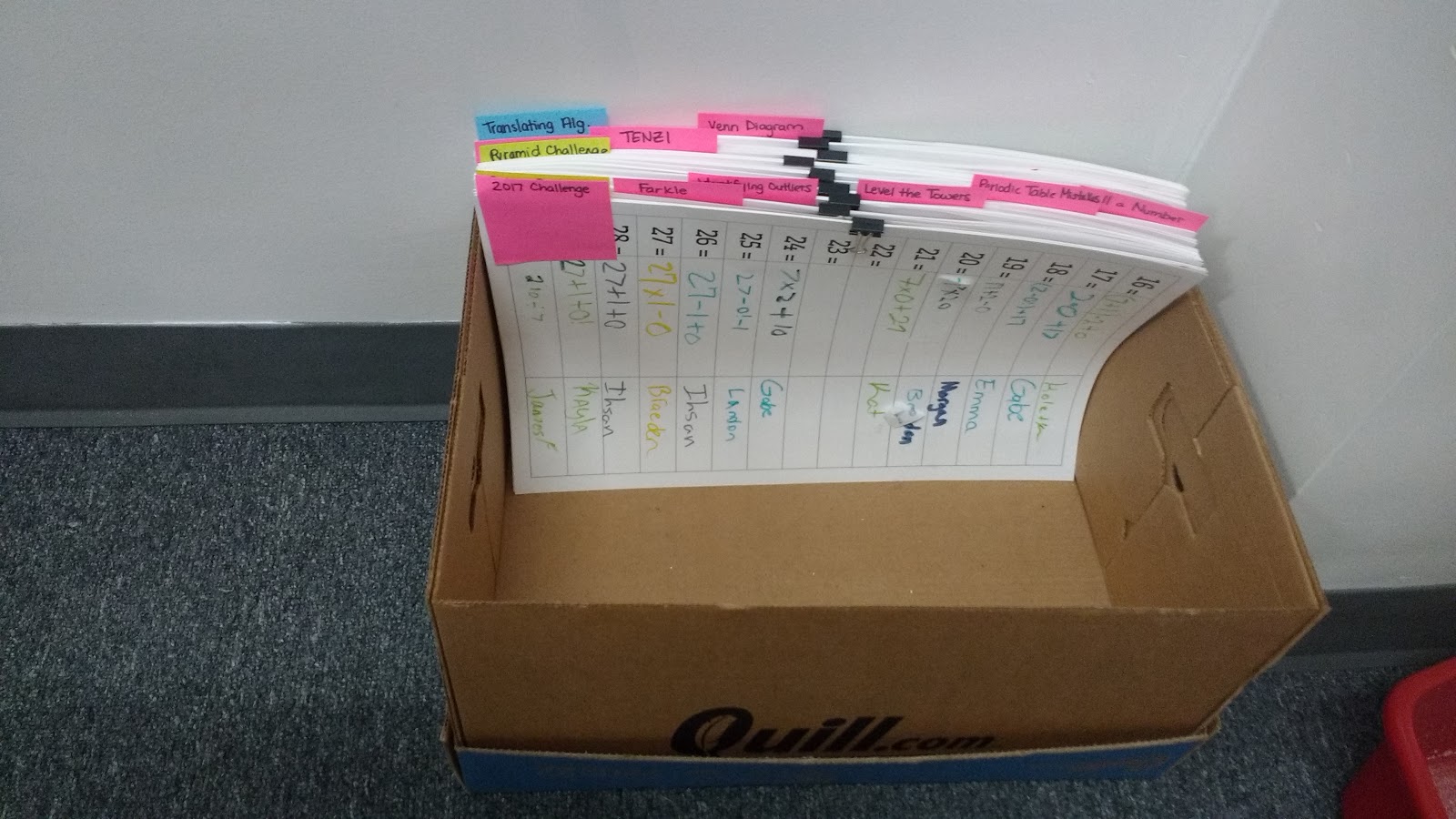
I created a home for no name papers. And, I’ve given myself permission to throw them out frequently if unclaimed. I tape my no name papers to this section of dry erase board that is behind my desk. Every few weeks when the board gets scary looking, I write a note on the board telling students to check the no name papers before a certain date or they will be thrown away.
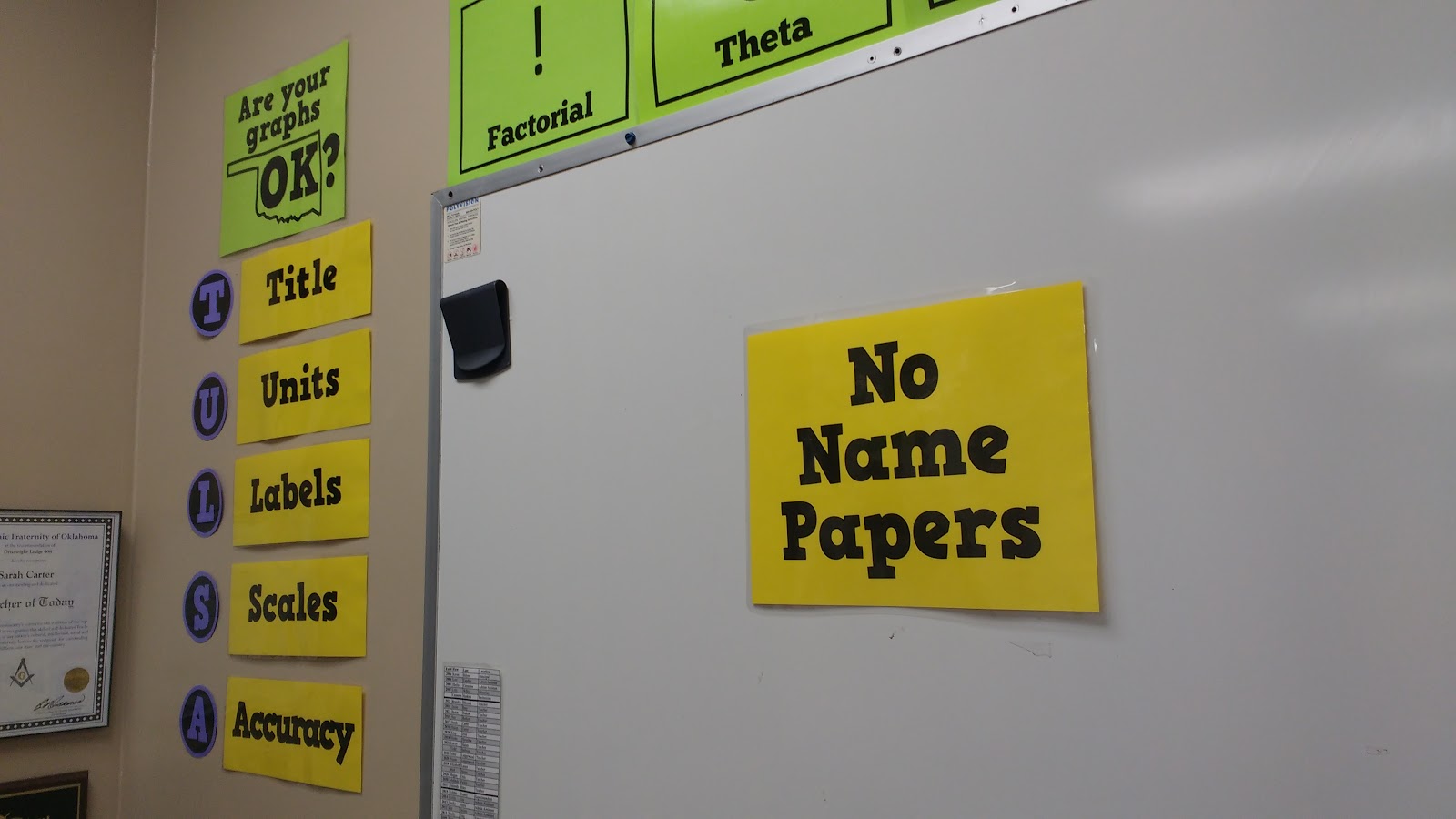
When students are gone, their missing work is easily accessible. Everything is sorted by skill code. Students grab another student’s notebook to see what they missed. Then, they get the missing papers from the appropriate folder.

I’ve started labeling EVERYTHING. This red drawer organizer has become my student supply center. Here, students can find a stapler, tape dispenser, and hole punch. In the drawers, students can find notebook paper, graph paper, and plain copy paper. Students no longer have to search around my desk for supplies to borrow. These are their supplies. The supplies on my desk are my supplies.
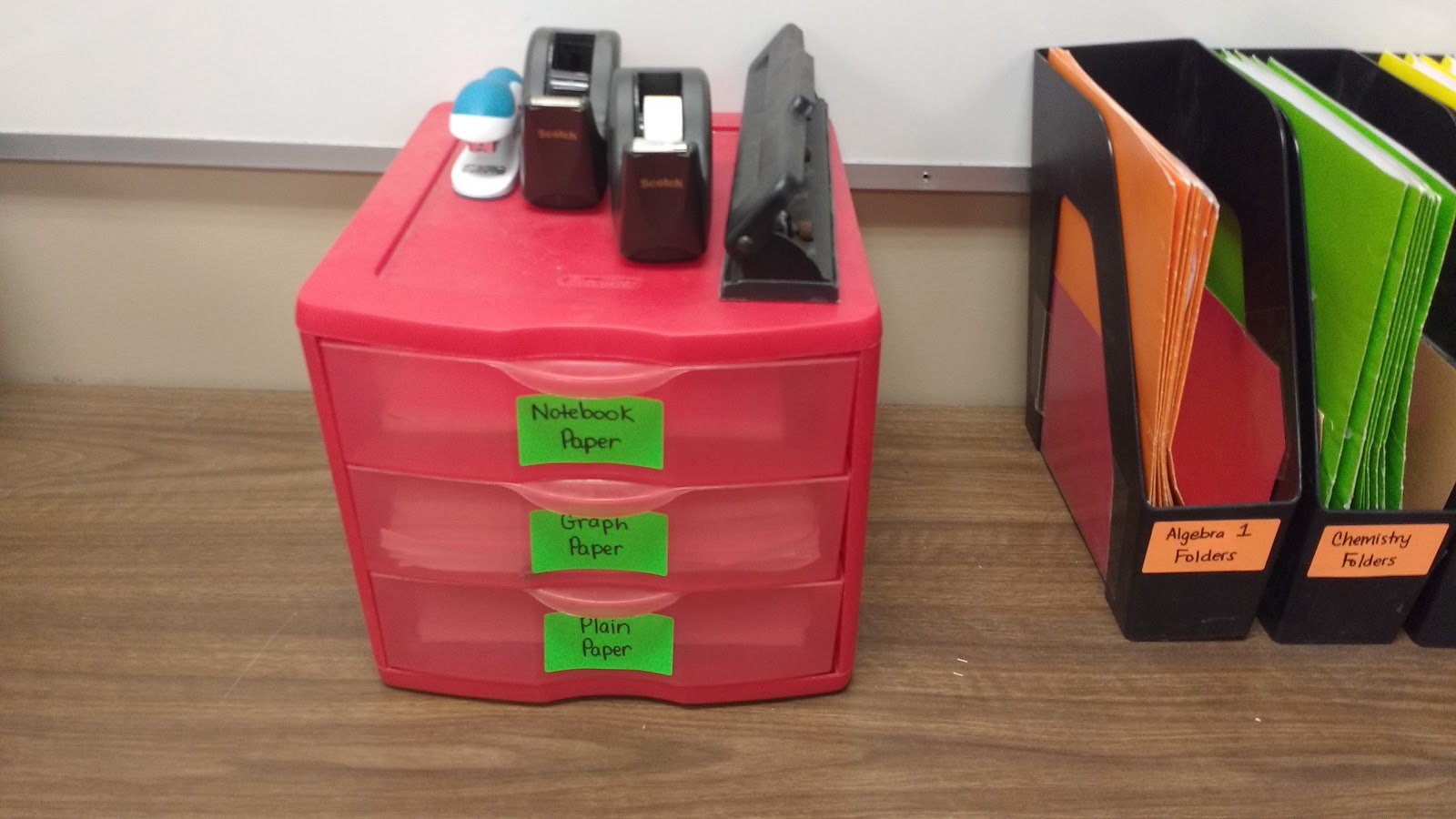
I adopted table folders for the first time. These have been super successful with my math concepts students, semi-successful with my chemistry students, and not at all successful with my algebra students. I could beat myself up for the ways in which this strategy did not work out. Instead, I know now what needs to be fixed to make these work better in the future. Next year, I will implement these more effectively. The important thing is that I am trying out new things. I am learning just as my students are learning. Teaching is not a sprint but a marathon. If I’m in teaching for the long run, I need to focus on gradual growth instead of perfection. Before beginning Angela’s program I would have described myself as a perfectionist. Now, I recognize that I still have perfectionistic tendencies, but I don’t have to give into those tendencies right now. It’s okay to say “I’ll perfect that NEXT YEAR.”
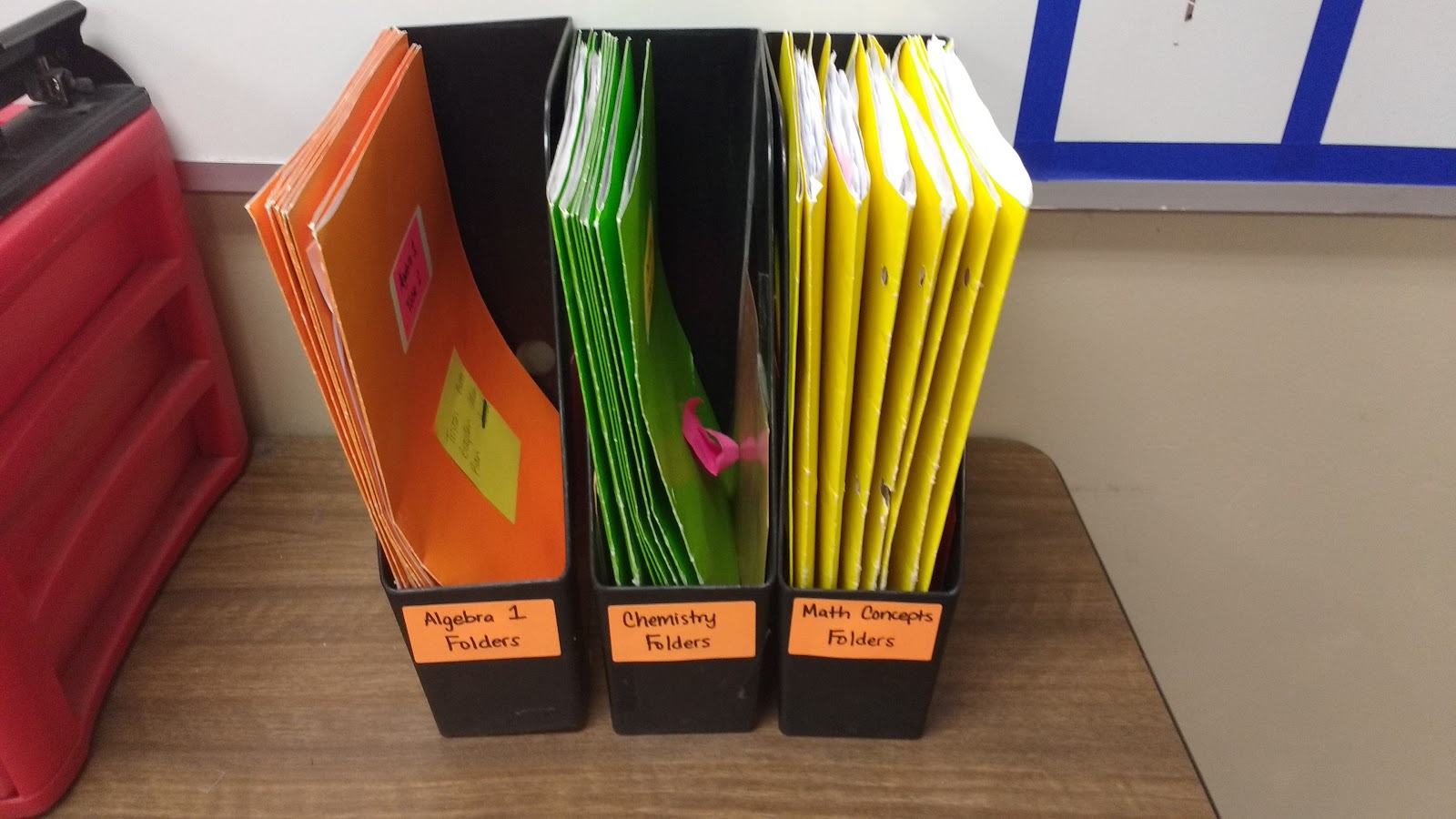
I started last year with empty bulletin boards. Usually, I feel compelled to decorate EVERY SINGLE SURFACE before students ever set foot in my classroom. This past year, I gave myself permission to leave my bulletin boards blank to make room to show off student creations. I’ve only decorated each board twice, but I’m not going to beat myself up about that.
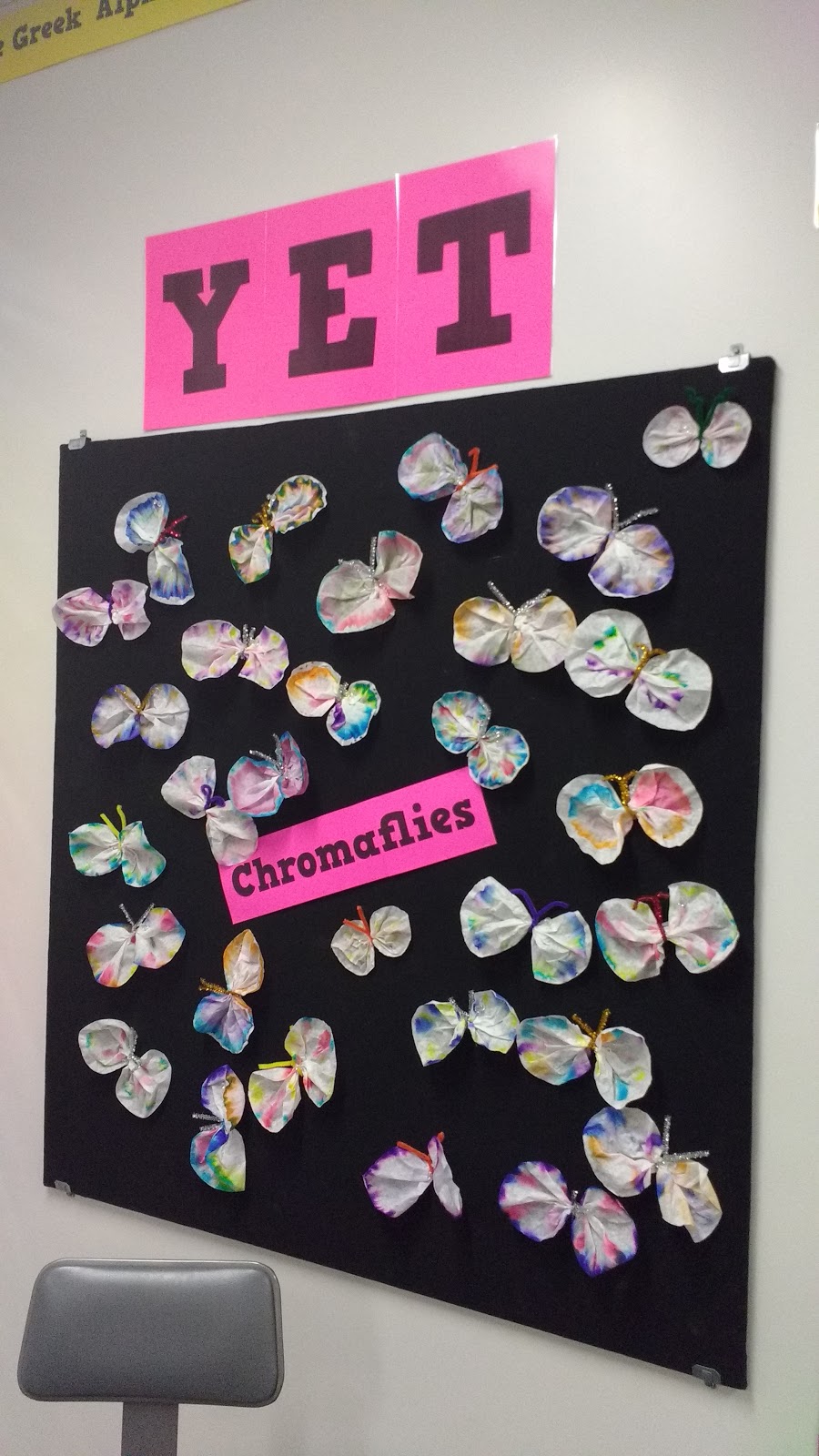
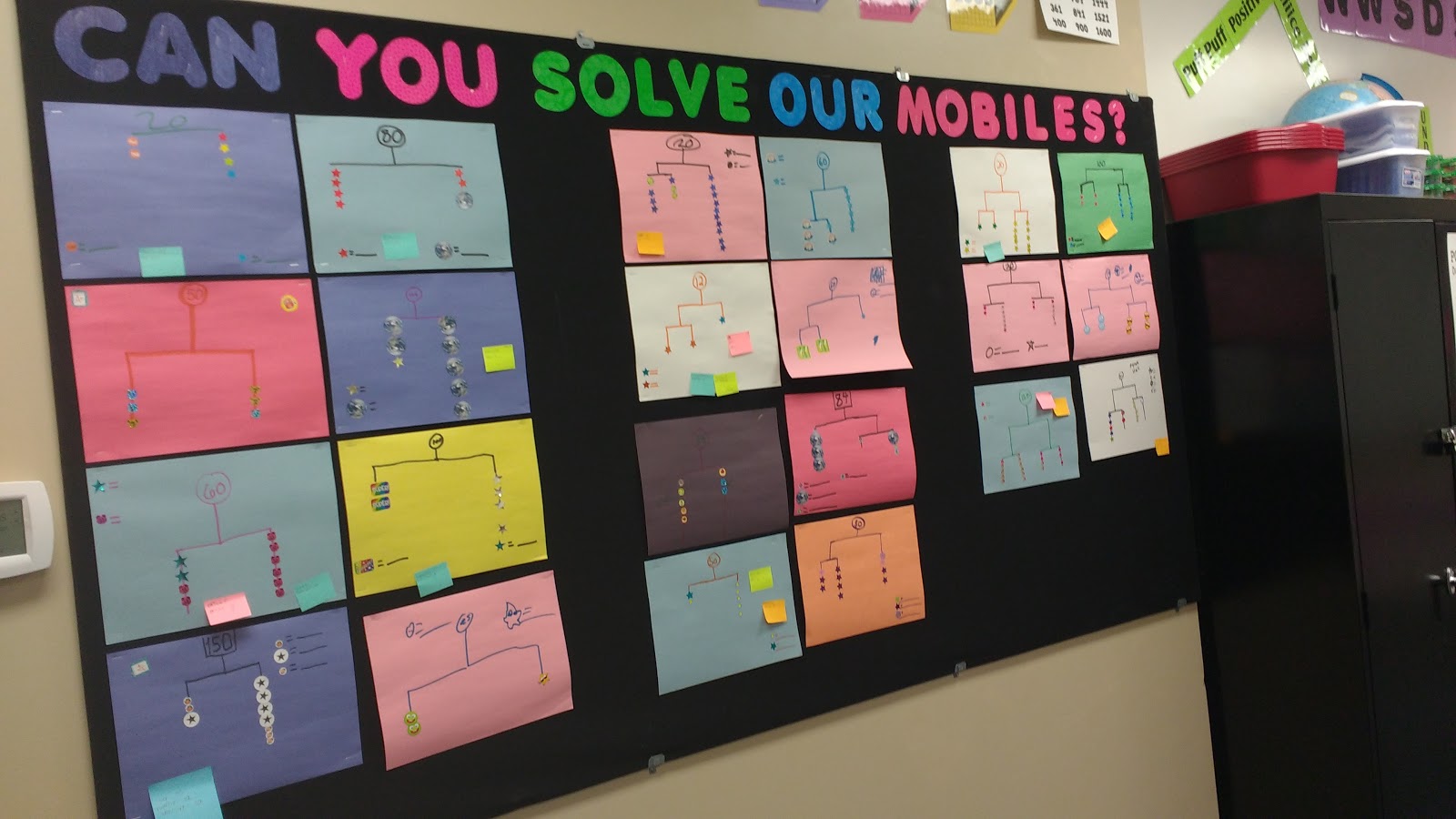
I created a new system for students to use when turning in their papers to be graded. In the past, I used stacking trays with a different tray for each period of the day, but I found that many students couldn’t get their papers in the right tray no matter how well I labeled them. This year, I have just three drawers. Each drawer holds all of the papers to be graded for each subject. I love that these drawers keep the papers fully contained. With stacking trays, the papers always seemed to overflow through the sides of the trays. This set of drawers sets on my desk so I can easily see what needs to be graded and grab papers to grade during lunch or my planning period.

I created an appointment calendar on my dry erase board. Students sign up here if they plan to come in for extra help, to serve detention, to take a quiz they missed, or to retake a quiz to improve their score. I no longer have to guess if I have time to run to the copy machine before school. I can glance at the board to see if a student is planning on coming in. If there are no names on the board, I can make a guilt-free trip to the copy machine.
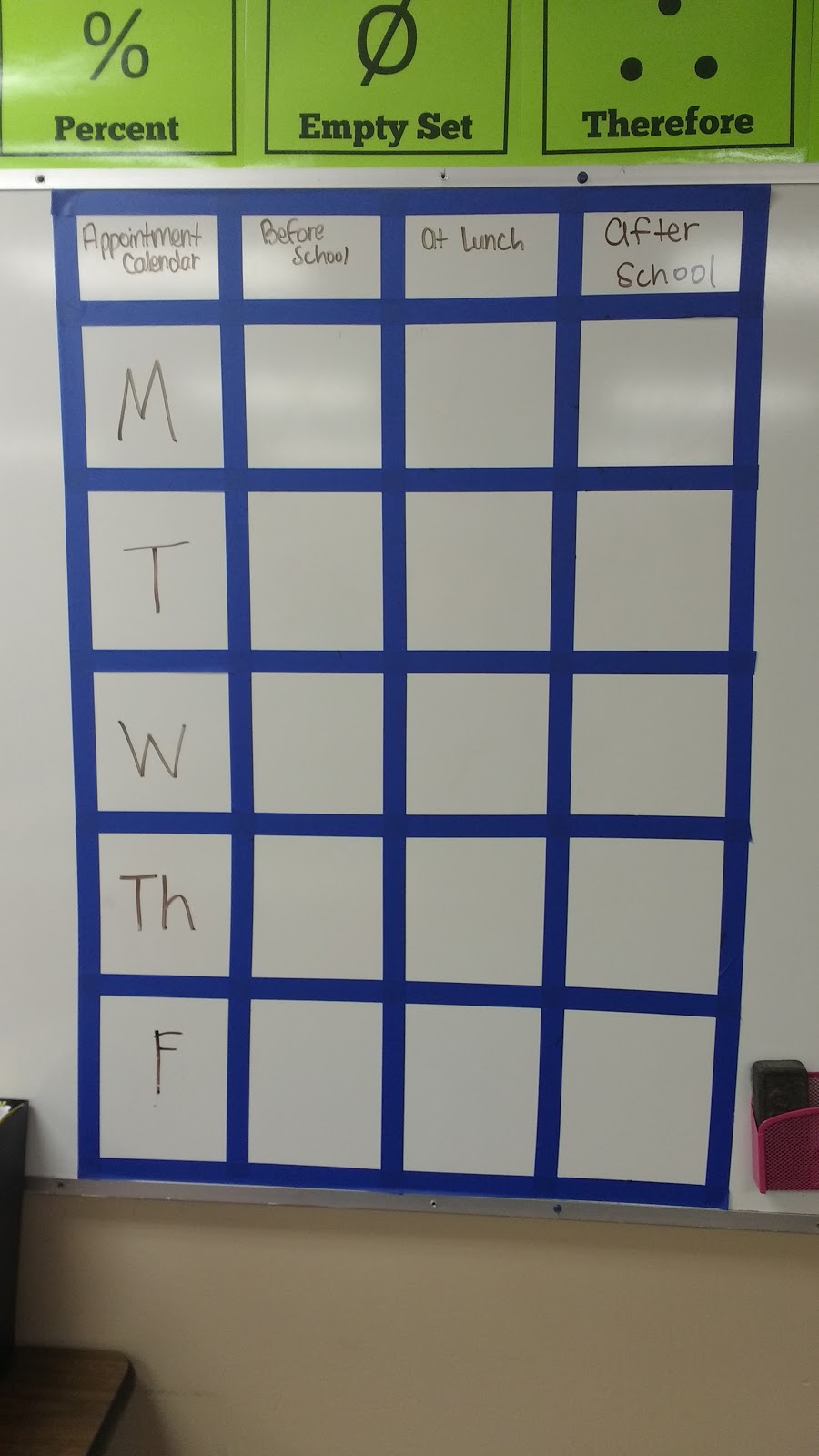
I apparently didn’t take a great photo of these magazine holder boxes, so this photo of my new phone with them in the background will have to do. I have three boxes which I use to sort things into. These boxes keep important things easily findable and NOT ON TOP OF MY DESK. I have boxes for “To Read,” “To File,” and “To Do.”
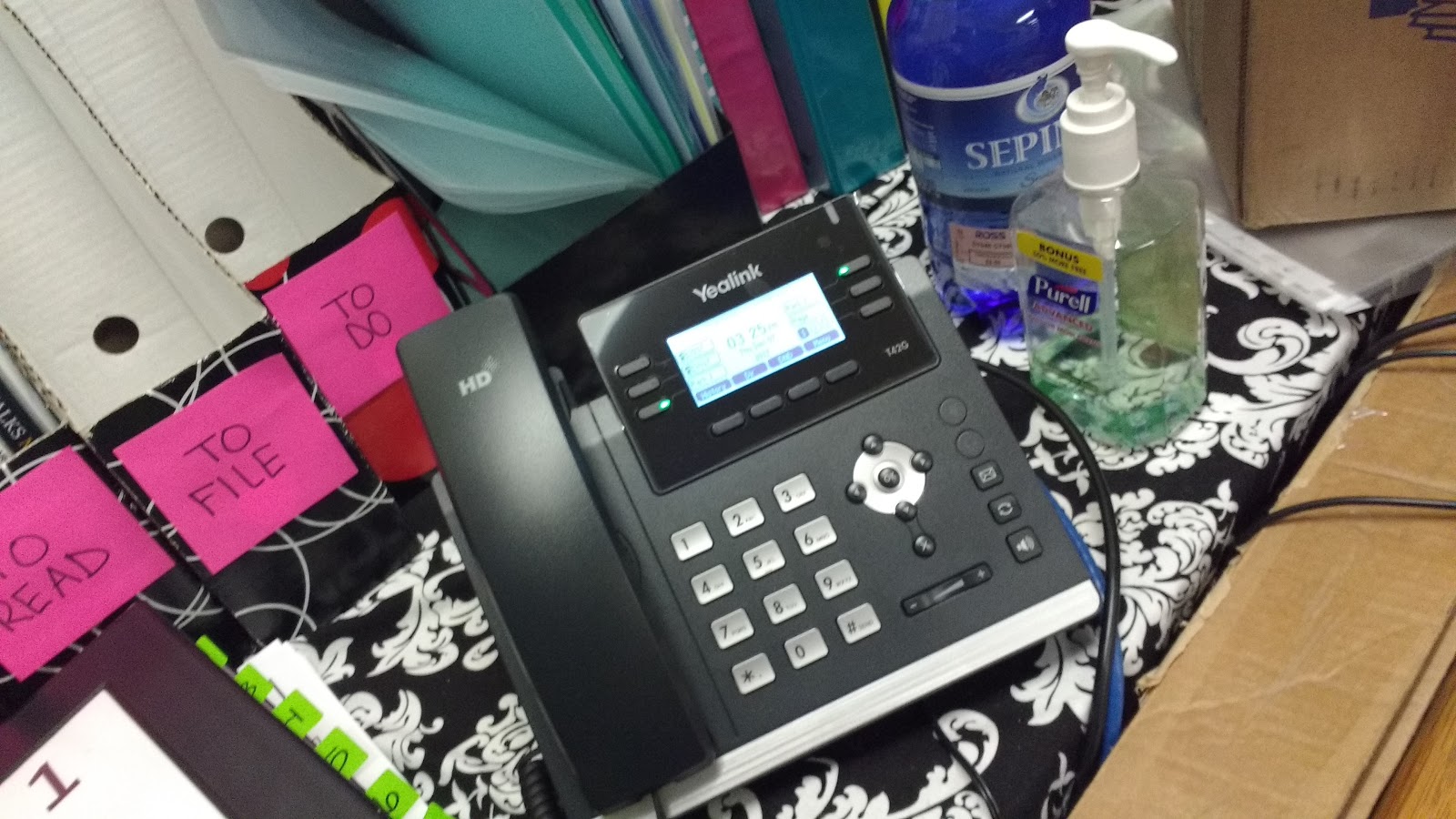
Instead of staying late sporadically after school to help students, my husband and I instituted what we call “Cookie Club.” On Mondays, we both decided to stay at school until at least 5:30 to offer tutoring. I baked cookies or a similar dessert for each Monday session. This made my week much more predictable. Students knew I will be at school late one day each week. For the rest of the week, I offered additional tutoring but for a much more limited amount of time. I didn’t have to feel guilty about this because I know that students have time each week for more extended help. One week, we even had a hot cocoa station to go along with our cookies.


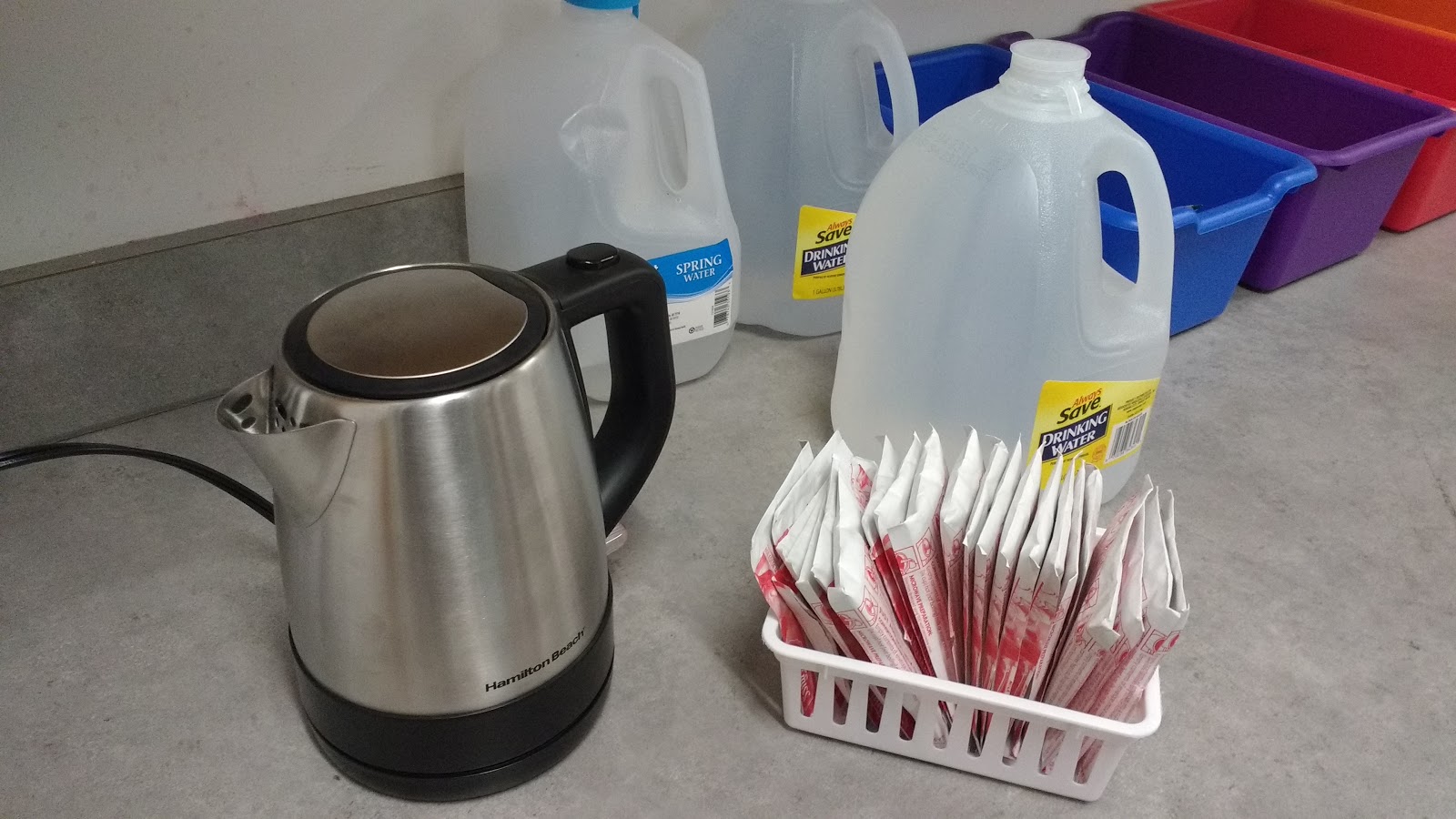
In the past, my desk has ALWAYS been a mess. It was so habitually bad, that students would regularly exclaim “Wow! You cleaned your desk!” since my desk being clean was such a rare occasion. Since using Angela’s organization tips and tricks, my desk stays so much cleaner. I even had room on my desk to add some decorations this fall.

I’ve started prepping my lessons by the week instead of by the day. This has been a huge game changer when it comes to productivity. I never realized just how much time I was wasting by thinking daily instead of more big picture. These are all the materials for an entire week of chemistry. I snapped this photo while preparing to load my table folders.
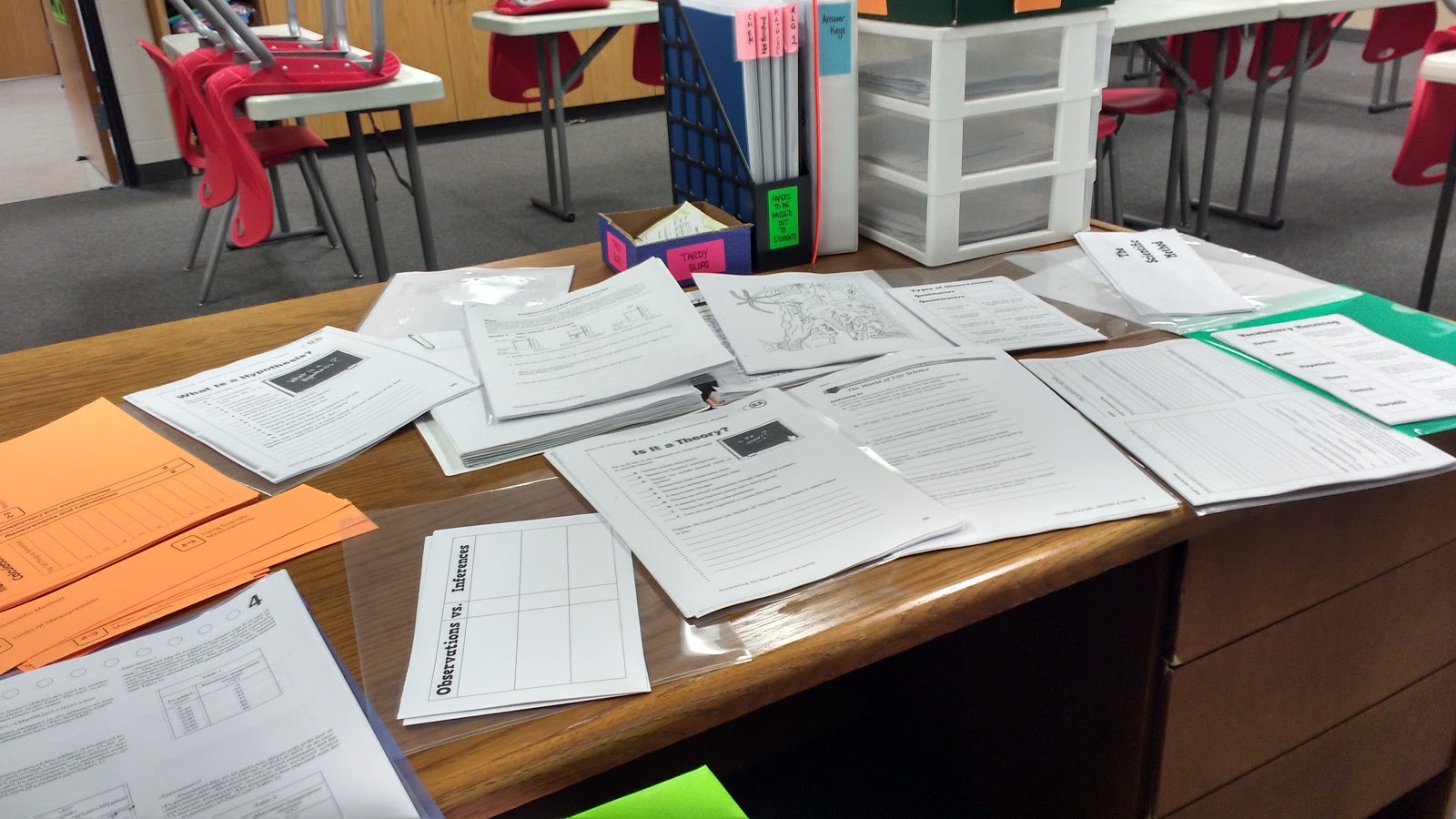
I created a user-friendly system for notebook checks that leads to consistent scoring. In the past, I’ve just flipped through notebooks while trying to remember what should be on each page. Now, I make a dry erase template at the end of each unit that lists every single thing that should be in my students’ notebooks along with a point value. I type it up in Excel and slip it in a dry erase pocket. Now, I no longer dread notebook checks.
MATH = LOVE RECOMMENDS…
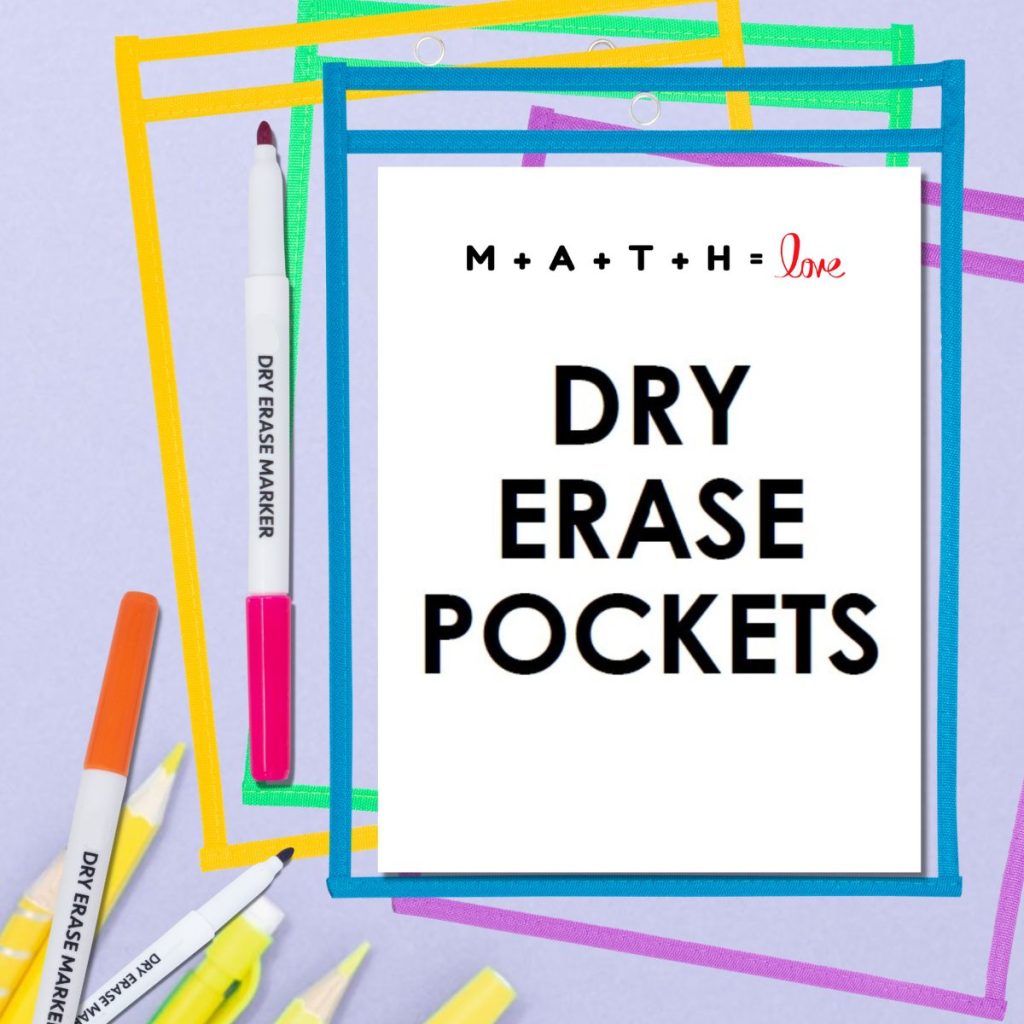
I cannot imagine teaching math without my dry erase pockets! They instantly make any activity more engaging and save me countless hours at the copy machine since I can use the same class sets of copies year after year.
Here are my current go-to recommendations:
If you don’t have a classroom set of dry erase pockets, you could also use heavy duty sheet protectors. But, I highly recommend investing in a classroom set of the pockets since they are so much more durable.
The 40 Hour Teacher Workweek program encourages you to think through the tasks you dread and brainstorm ways to streamline them and make them routine tasks that are easy to implement on a regular basis.
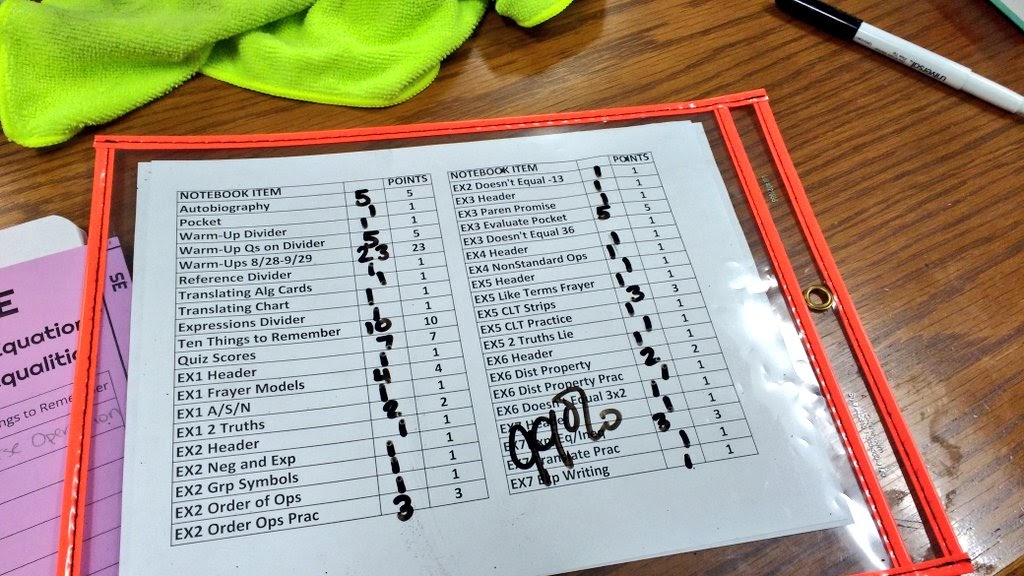
I bought a set of baskets at Dollar Tree this summer that I now use as “project baskets.” These keep my materials contained and so much more organized than my old method to just sit stuff on my desk and back counter.
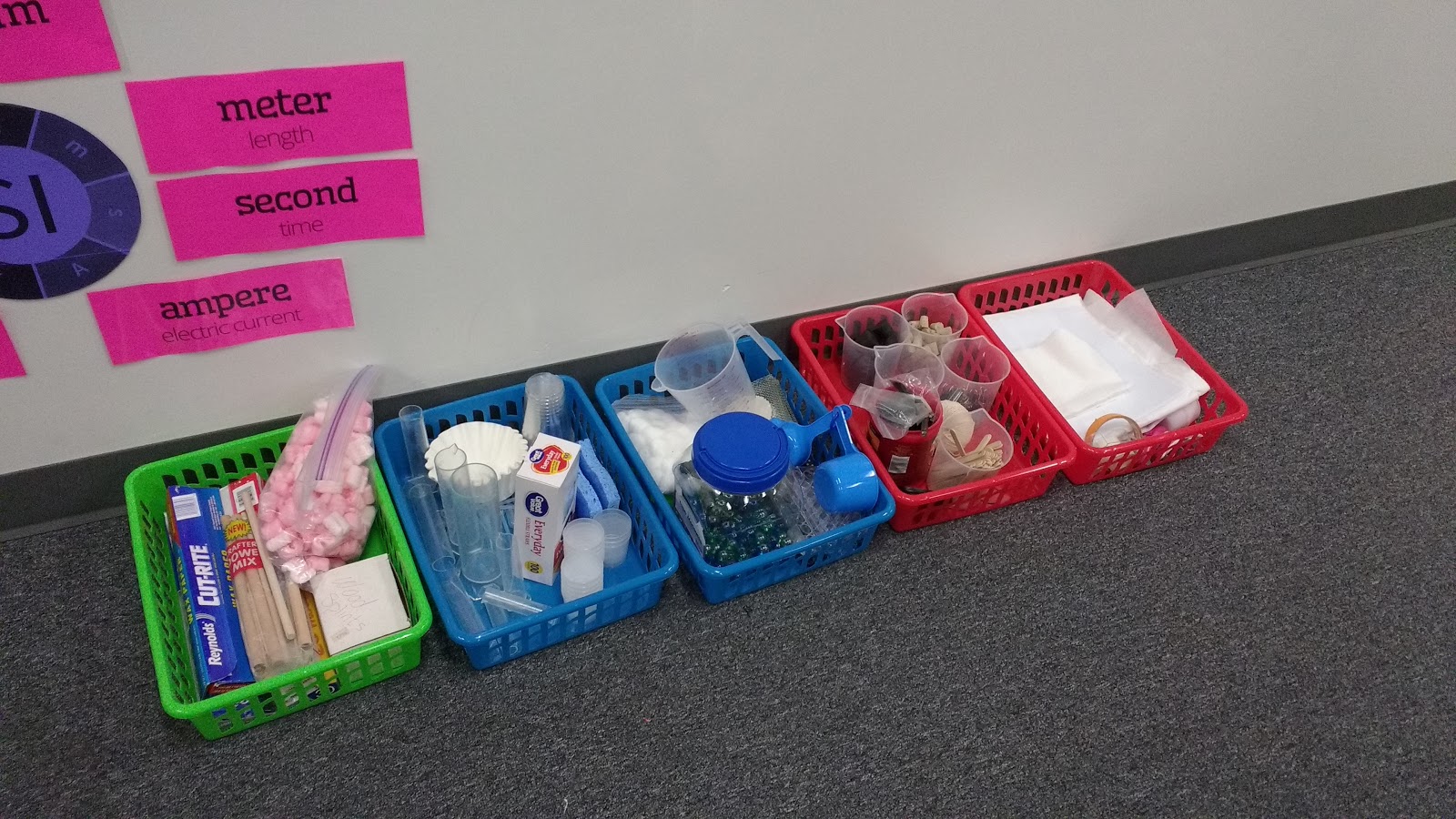
For my entire teaching career, I have saved the notes, cards, pictures, etc. that I have received from students. These have been stuffed into various filing cabinet folders, but I recently became frustrated by the fact that these overflowing folders were taking up valuable file cabinet space. I still wanted to keep these mementos, but I knew I needed a new system. I picked up a decorative box at Tuesday Morning that now holds my teacher memories. Now I know that all of my special memories are in one special place.
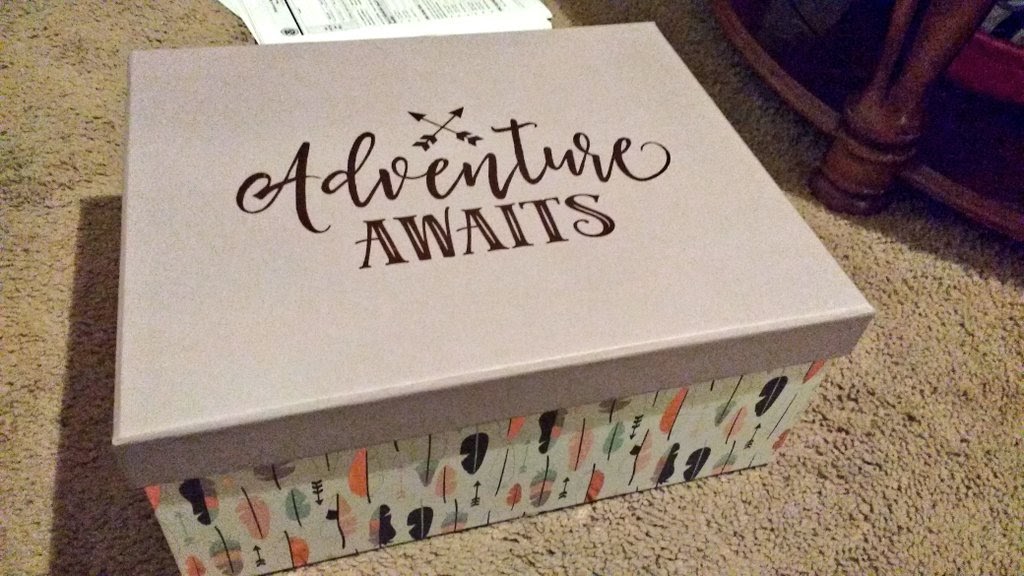
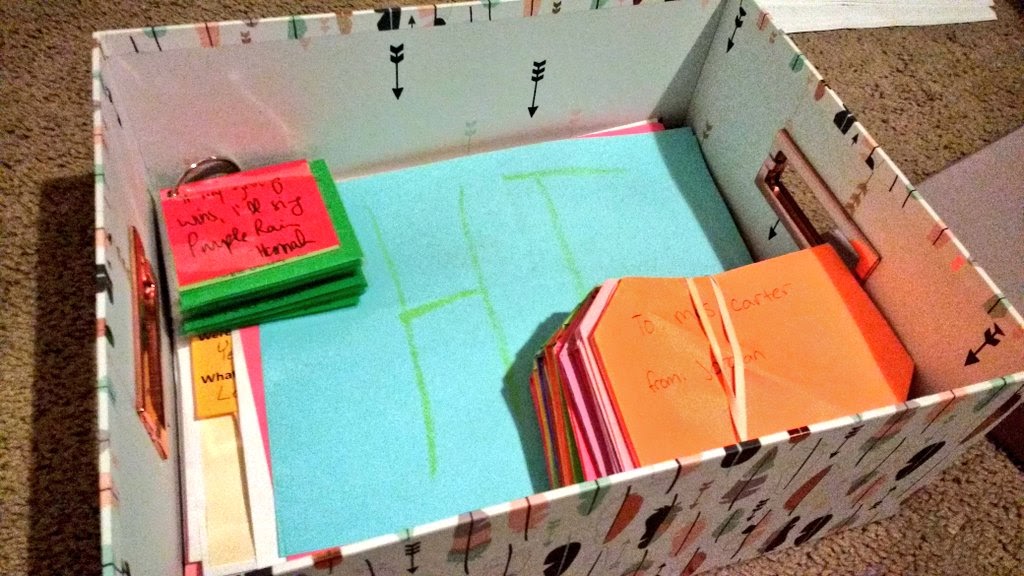
I first started using these plastic sleeves last year upon suggestion of my husband. These plastic sleeves make it easy to keep papers sorted without having to orient each set of papers in opposite ways. That method is always great until you need to remove something from the middle of the stack and have to waste time trying to reorient the papers to keep your pattern. These have been especially useful because Angela Watson has taught me the magic of “batching.” This is one of the most useful strategies I have taken away from the club. The idea is to take necessary tasks and combine them so that they take less time when done all at once.
For example, I started out the year in chemistry doing a practice ACT science passage every single Monday. I could have printed a new passage every Monday morning. That’s what past me would have done. Instead, I took part of my planning period one day and printed 14 passages. This meant that I didn’t have to think about our weekly passage for months. Instead, it was ready to go with no work on my part. The plastic sleeves made it simple to keep each passage separate from the others.
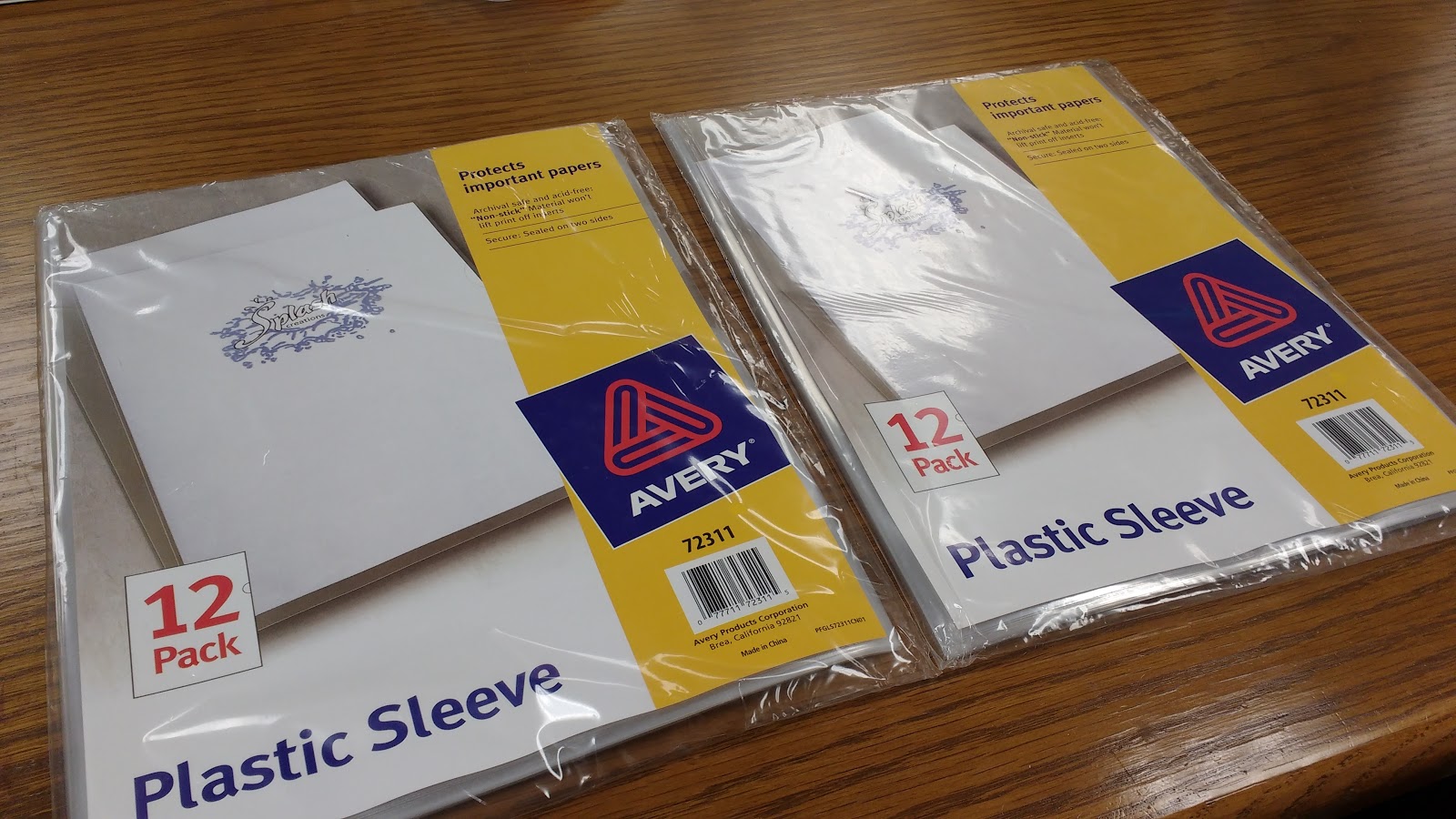
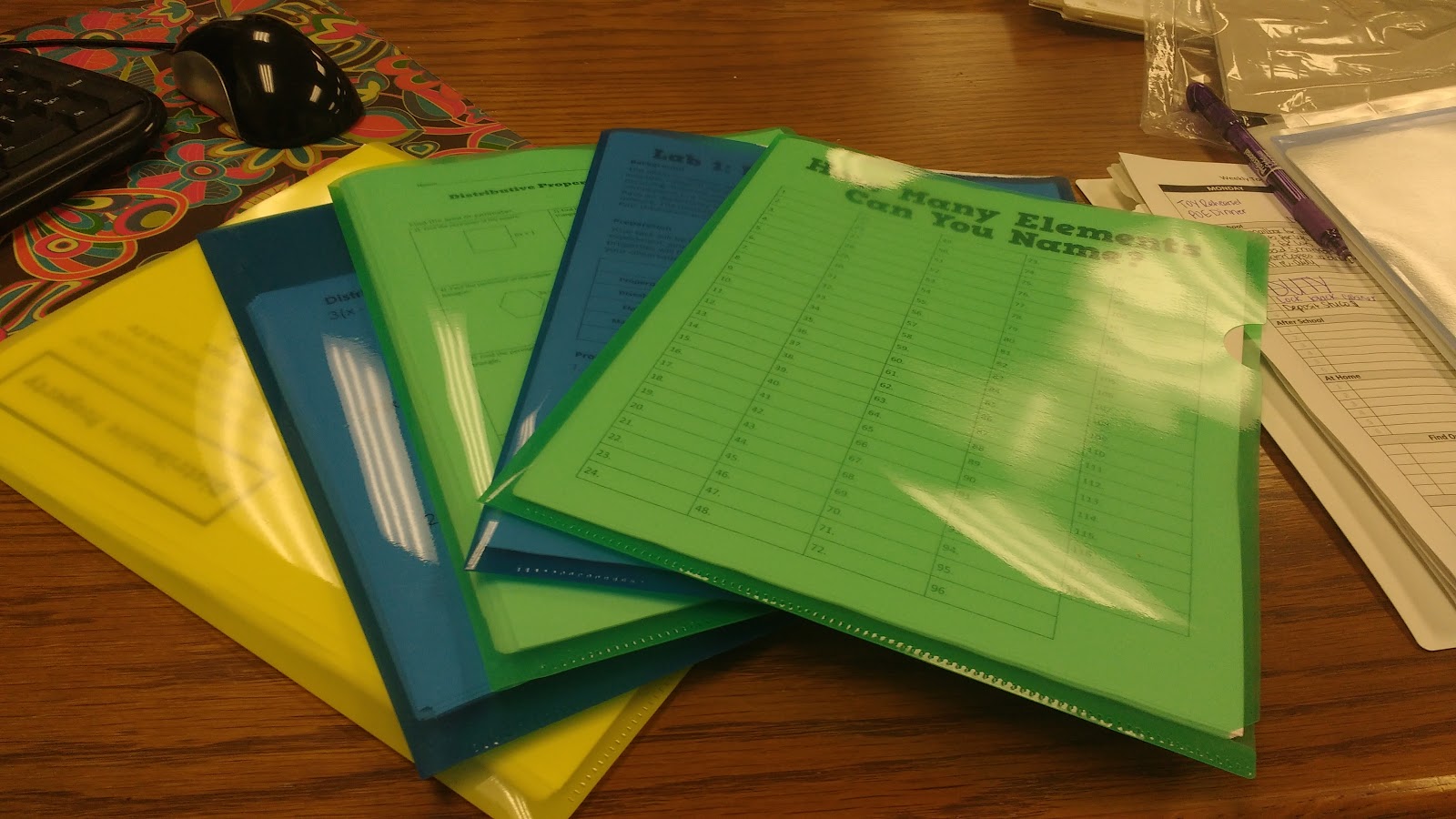
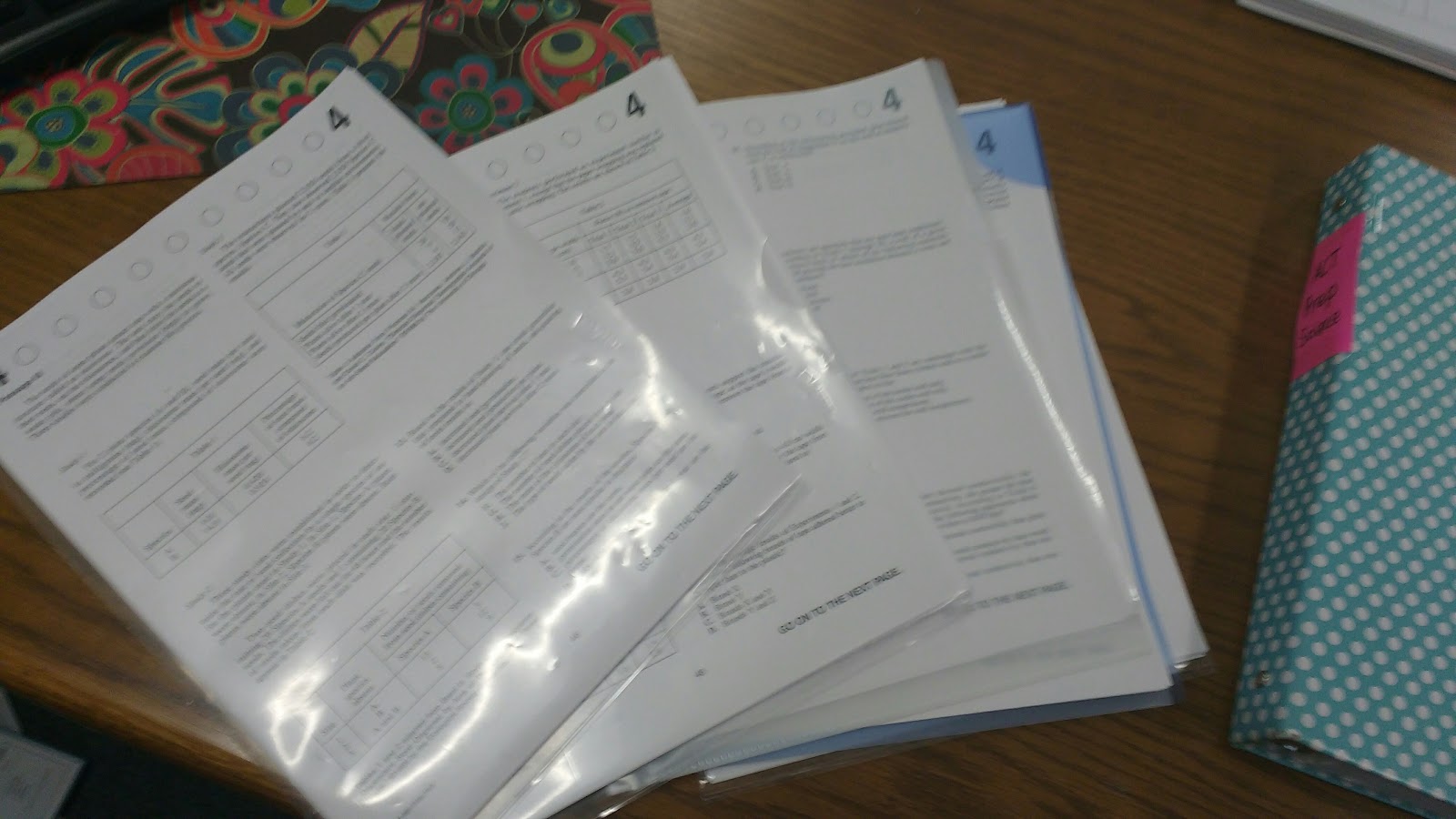
Embracing the concept of batching did lead to a problem I’ve never really had before. How do store all my copies when I make them WAAAAAAAAAAAAAAAYYYYYYYYY ahead of time? In the past, I was at the copy machine EVERY. SINGLE. MORNING. This was problematic because our copy machine has not always been super reliable. I spent way too much time having to make last minute lesson adjustments because the copy machine was out of order. This wouldn’t have been an issue if it wasn’t for my last minute planning tendency. This new-found problem of needing to organize a much larger quantity of copies than in the past led to a new organization strategy: a three drawer divider to hold my batched copies. One drawer holds INB dividers for every unit of Algebra 1. The second drawer holds INB dividers for Chemistry. The last drawer holds my ACT Science Passages. I love that these are easily accessible, but they don’t get mixed in with my more immediate copies.
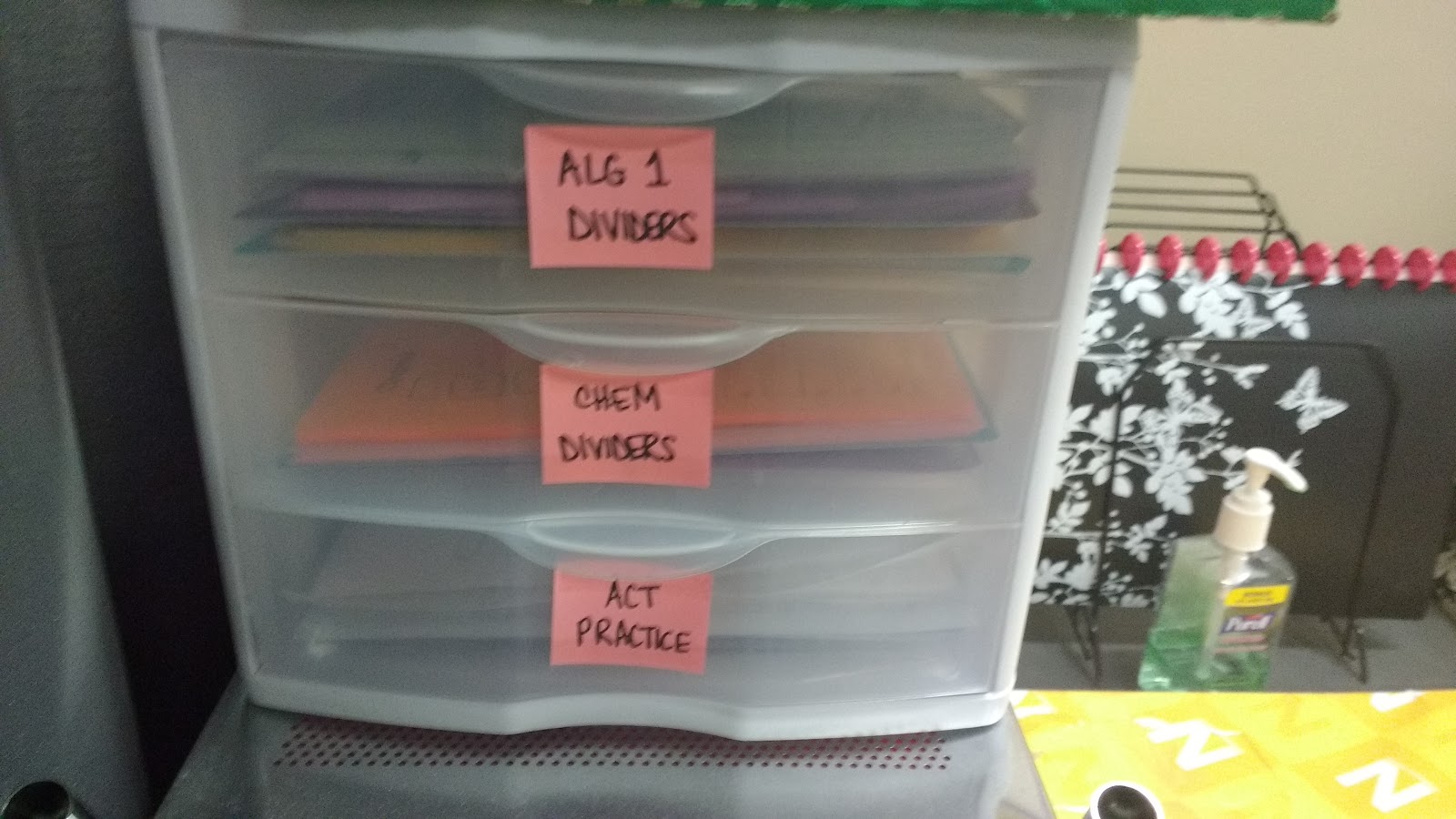
This year, I have also been inspired to embrace binders. I don’t know why it took me six years of teaching to get to this stage. I tried using binders as a first year teacher, and I got behind on filing things away. That was the end of my binder system. This system is much more focused and sustainable. It also makes it much easier to take exactly the papers home with me that I need over the weekend. Organization for the win!
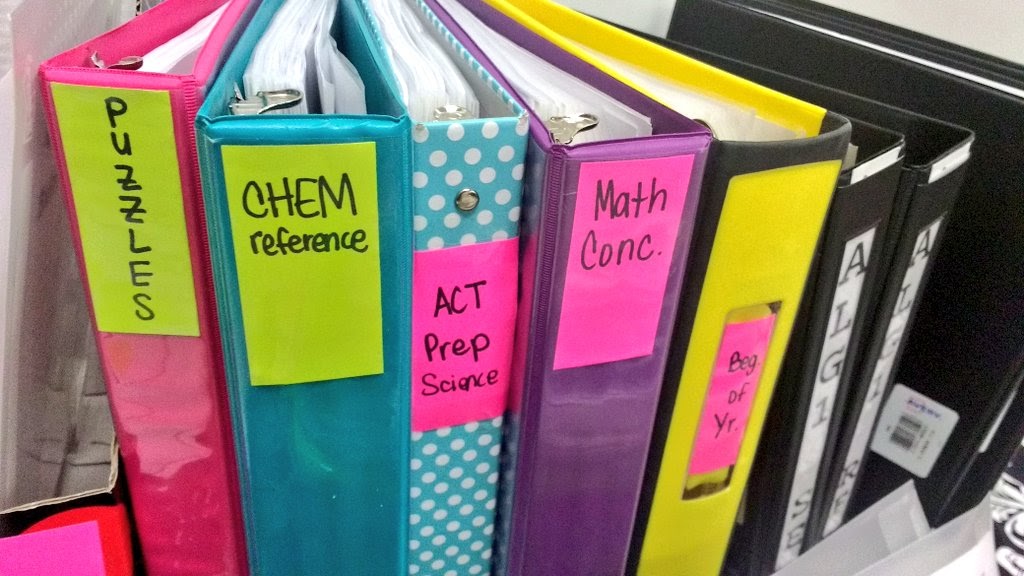
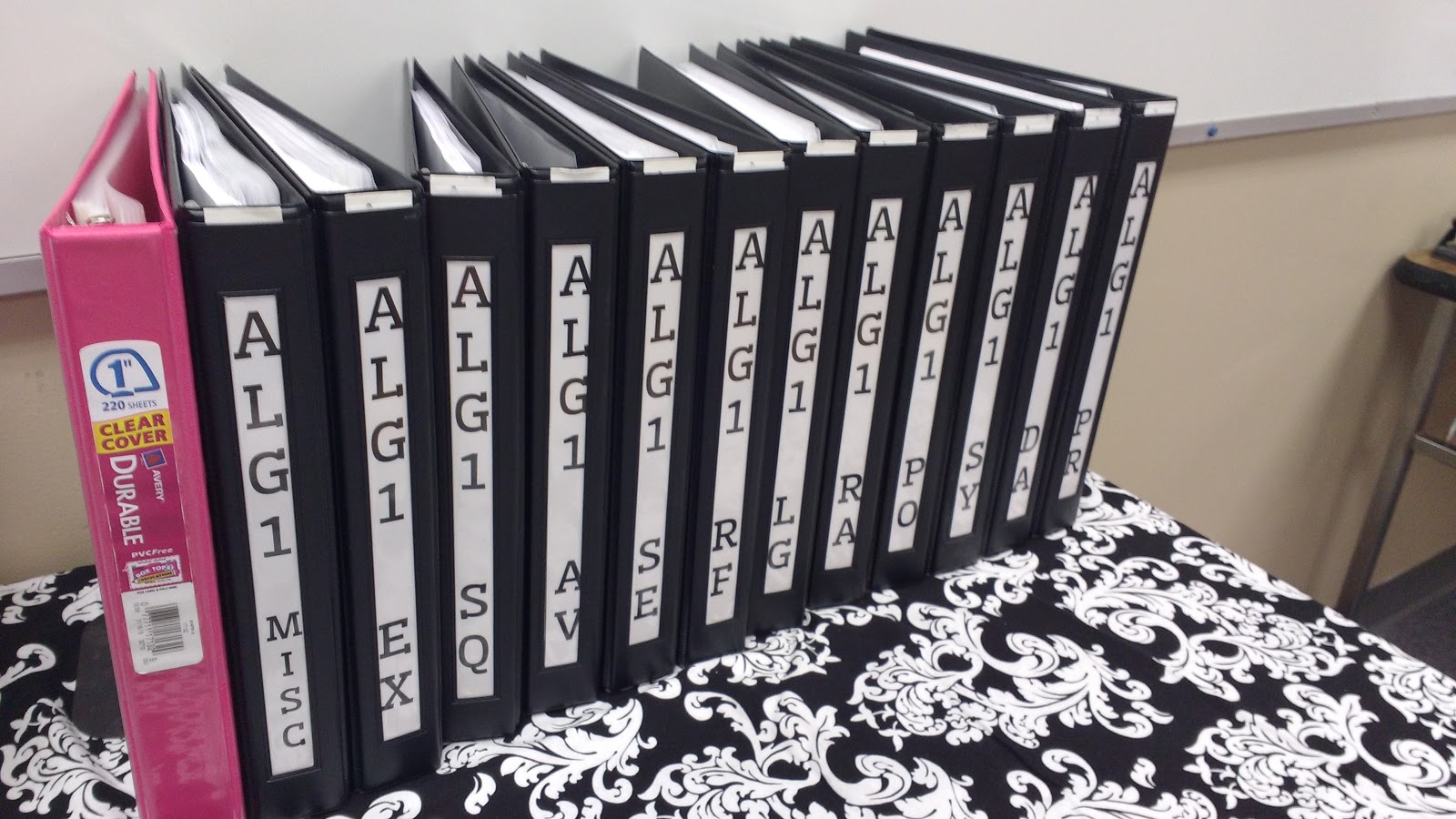
I’m continuing to hone one of my favorite binders: my answer key binder. I write four versions of each quiz, so I have A LOT of answer keys to keep up with. I like to give stickers to the students who earn a perfect score on their quiz the first time. In the past, I kept my stickers in a drawer. I would always waste time digging for these stickers whenever I went to grade papers. Now, the stickers live in my answer key binder. SO much time saved. This club has made me spend a lot of time thinking about the way I do things, and all of that time has truly paid off as a result of small tweaks like this.
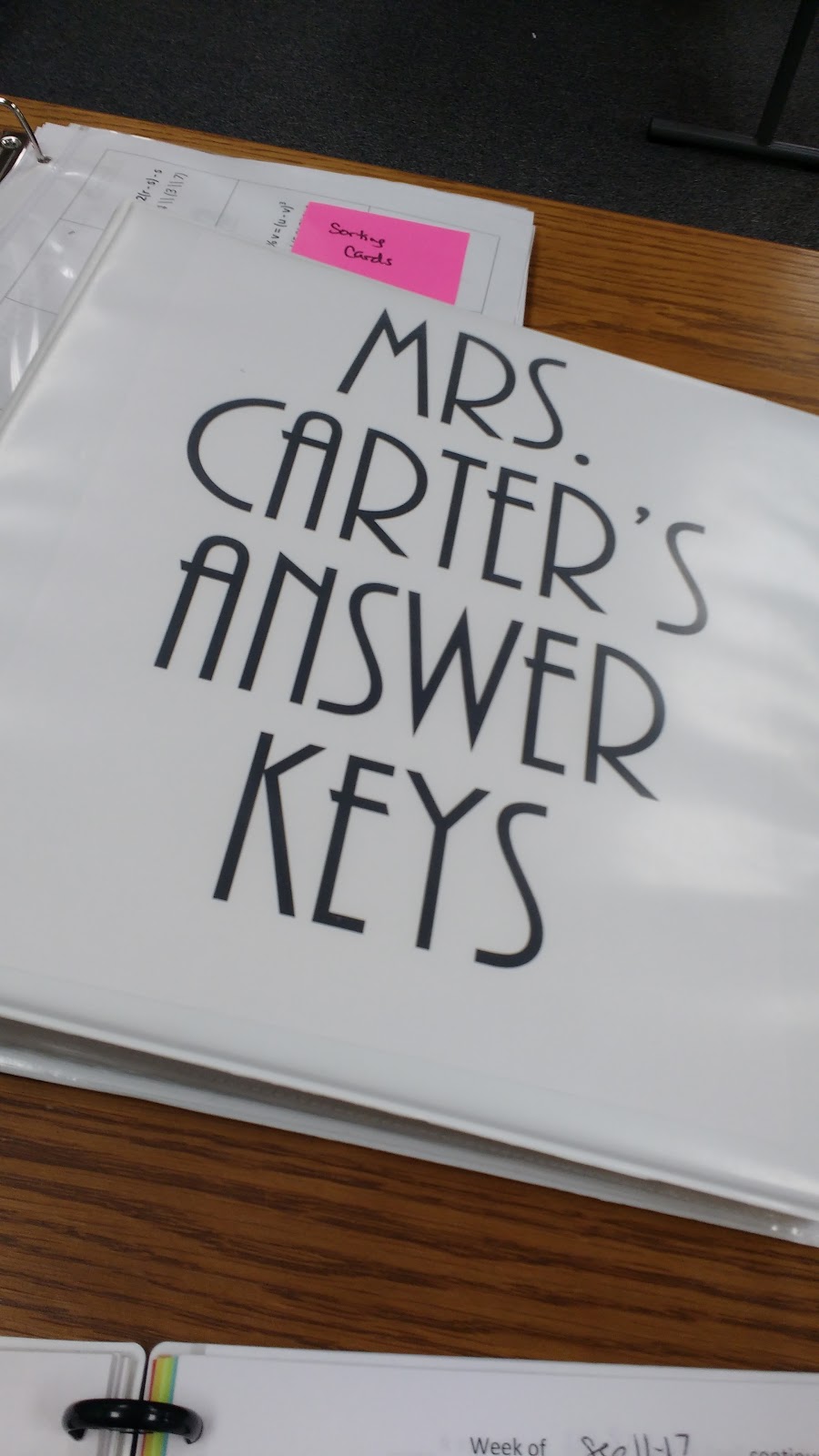

Remember the classroom jobs I mentioned earlier? I added another binder to my classroom this year that lives on my podium. It has an attendance sheet that my attendance keeper uses to take roll each hour. The attendance keeper than either tells me who is absent or writes the name of the absent students on the board. When I finally catch a minute of class time where I can take roll, I just have to look up at the board and see who is absent.
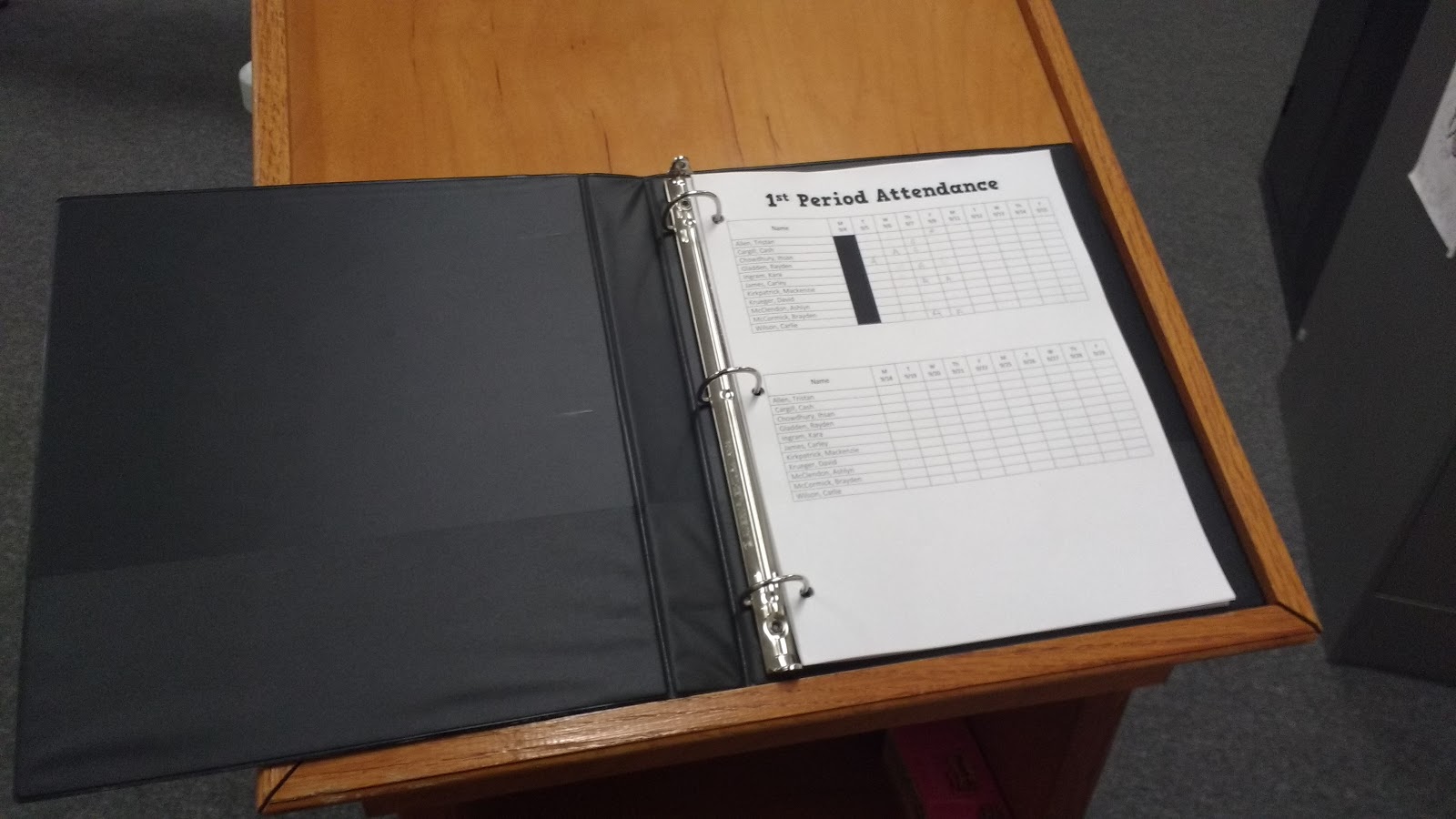
Before school started, Angela Watson advised the club members to think about organizing all the papers that we deal with on a daily basis in our classrooms. Every paper should have a home. This is an idea I hadn’t embraced in the past, and it always led to papers stuffed in drawers and stacked in piles on my desk. Here are some of the ways I have tackled my paper organization issues this year.
I still remember a problem I ran across as a first year teacher. When I had set up my classroom, I had put up a set of trays for students to turn their work into. What I hadn’t thought of, however, was where I was going to put my students’ papers once I graded them. I ended up with
piles of graded papers and no place to put them.
This year, I tried a new method to wrangle my graded papers, and I think it’s a keeper. I purchased a set of Avery Flexiview Six-Pocket Organizers last year. I designated one organizer per prep to hold my graded work. I am able to label the pockets inside with the period number to help me file away papers and help students find their graded papers more easily. I also love these organizers for keeping papers from getting bent up in my school bag.
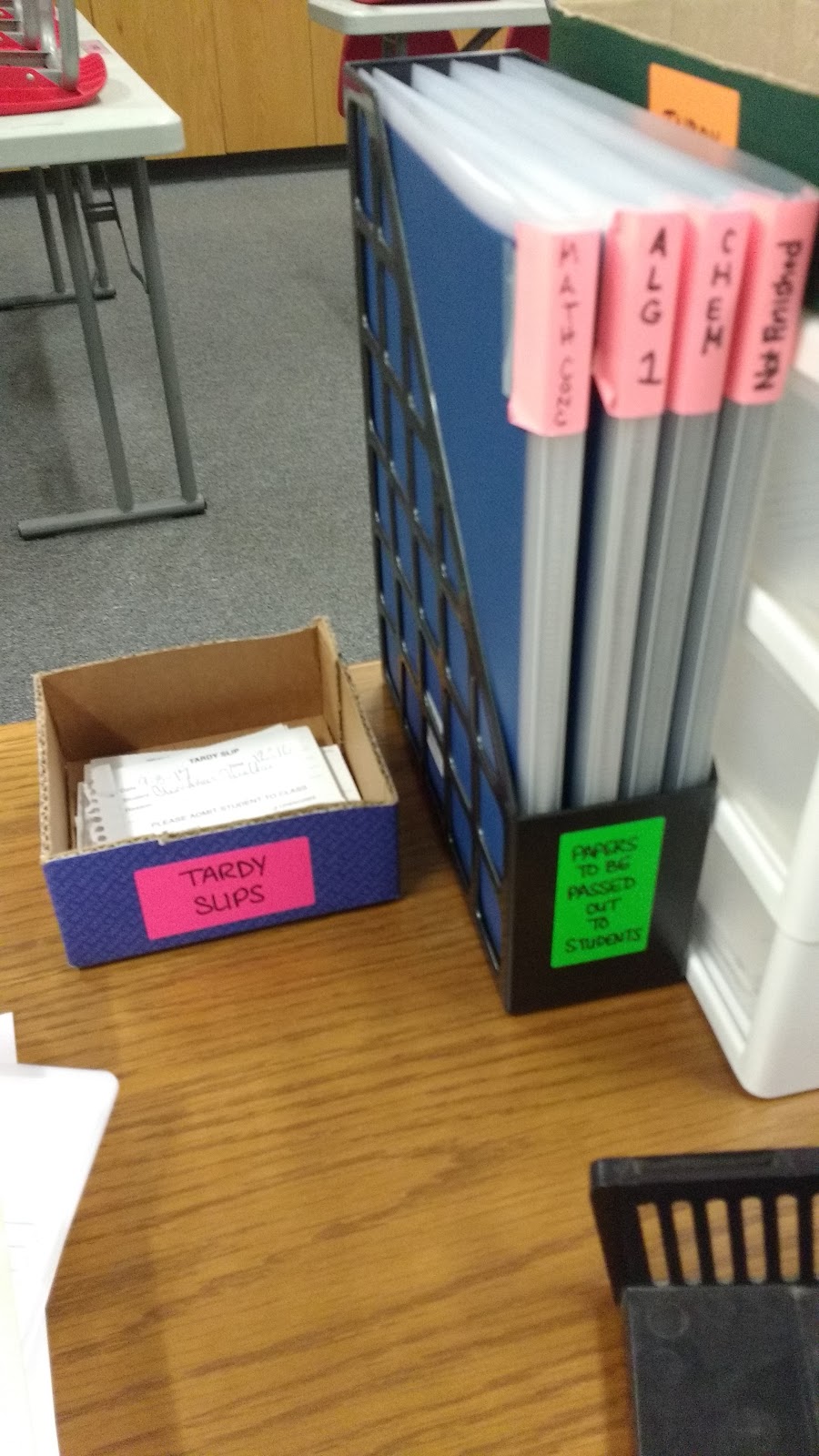
Each hour, I have a designated student whose job it is to pass back the graded papers. Remembering to pass back papers has been a career-long struggle for me. I always get so busy doing what I love (teaching) that I forget to do many of the more administrative duties during the class period. Yes, I’m that teacher who sometimes makes it to sixth hour and realizes they haven’t taken attendance ALL day long.
Often, I have students who want to stop by before school to get their graded quiz from the previous day. These students know exactly where I keep the graded paper folders, and they can get their graded work without having to disturb me.
I also ran into the problem of what to do with all of the tardy slips that students bring me. In the past, I always stuffed these in a drawer. This year, I placed a small box on my desk labeled tardy slips. It took a few weeks to train students to always put their tardy slips in the box, but the payoff has been awesome. My desk is no longer cluttered with tardy slips!
Another suggestion Angela Watson made to the club members was to have an “INBOX” where you place things that students/teachers/etc hand you that aren’t homework. The idea is to place the papers in a designated place until you have time to deal with each paper later. I have to admit that I haven’t done the best job of utilizing this box this year. I’m not sure if the idea doesn’t work for me or if I just need to make some small tweaks. I still think it’s a great idea, though. This box sits right on top of my turn-in trays for student work.
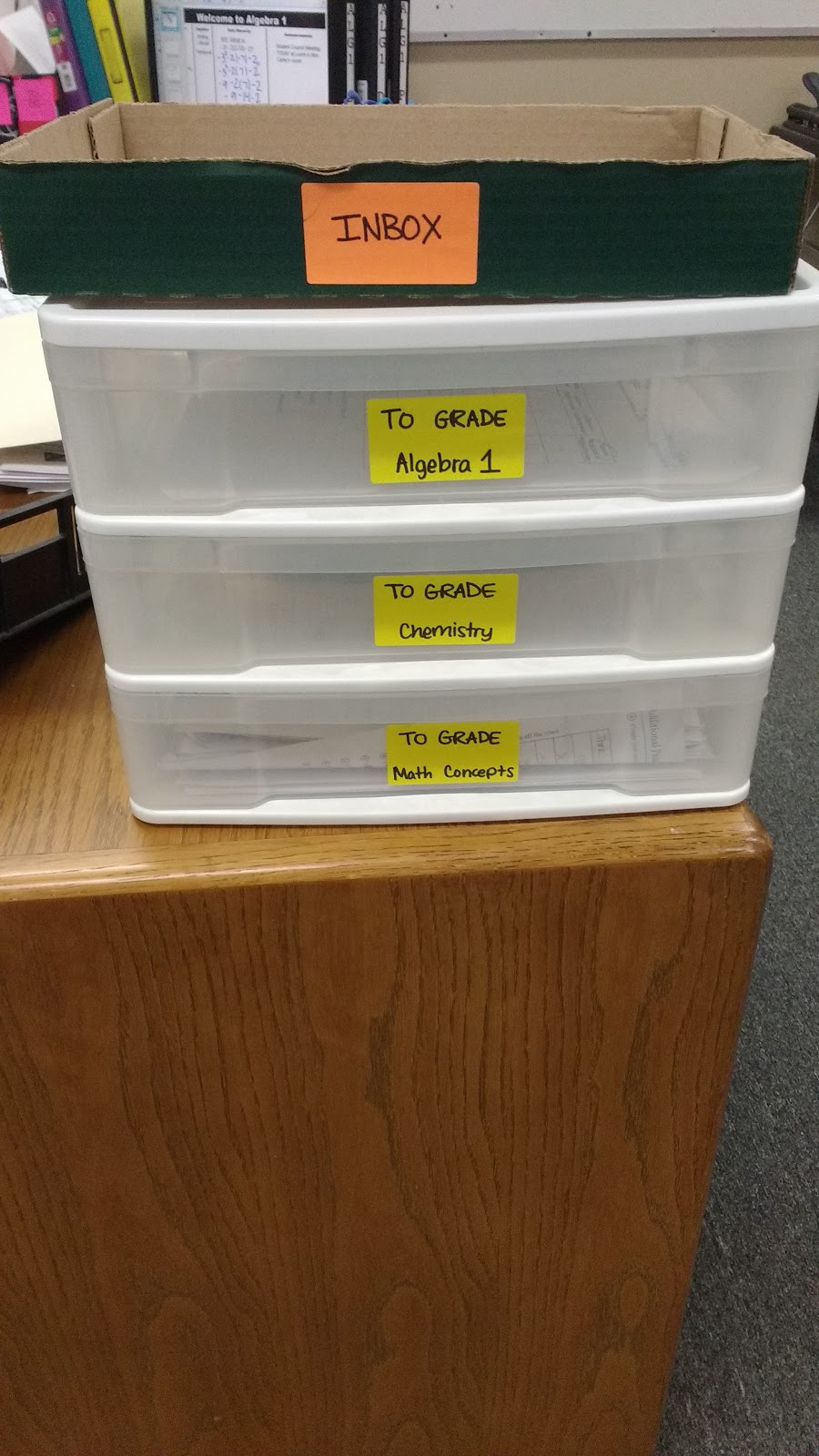
Over the last few years, I have wasted way too much time searching for my teacher-copy of our interactive notebooks. This year, on Angela’s advice, I decided to give them a definite home in my classroom. I designated a magazine holder to hold my notebooks. In here, I keep my copy of this year’s current Algebra 1 and Chemistry notebooks. I also keep my copy of last year’s Algebra 1 notebook so I can easily reference it when I need to remember how I taught something last year. Sometimes I still misplace it on my desk when I have it out and accidentally set something on top of it. But, for the most part, my notebooks live in their little home and can be easily accessed whenever I need them.
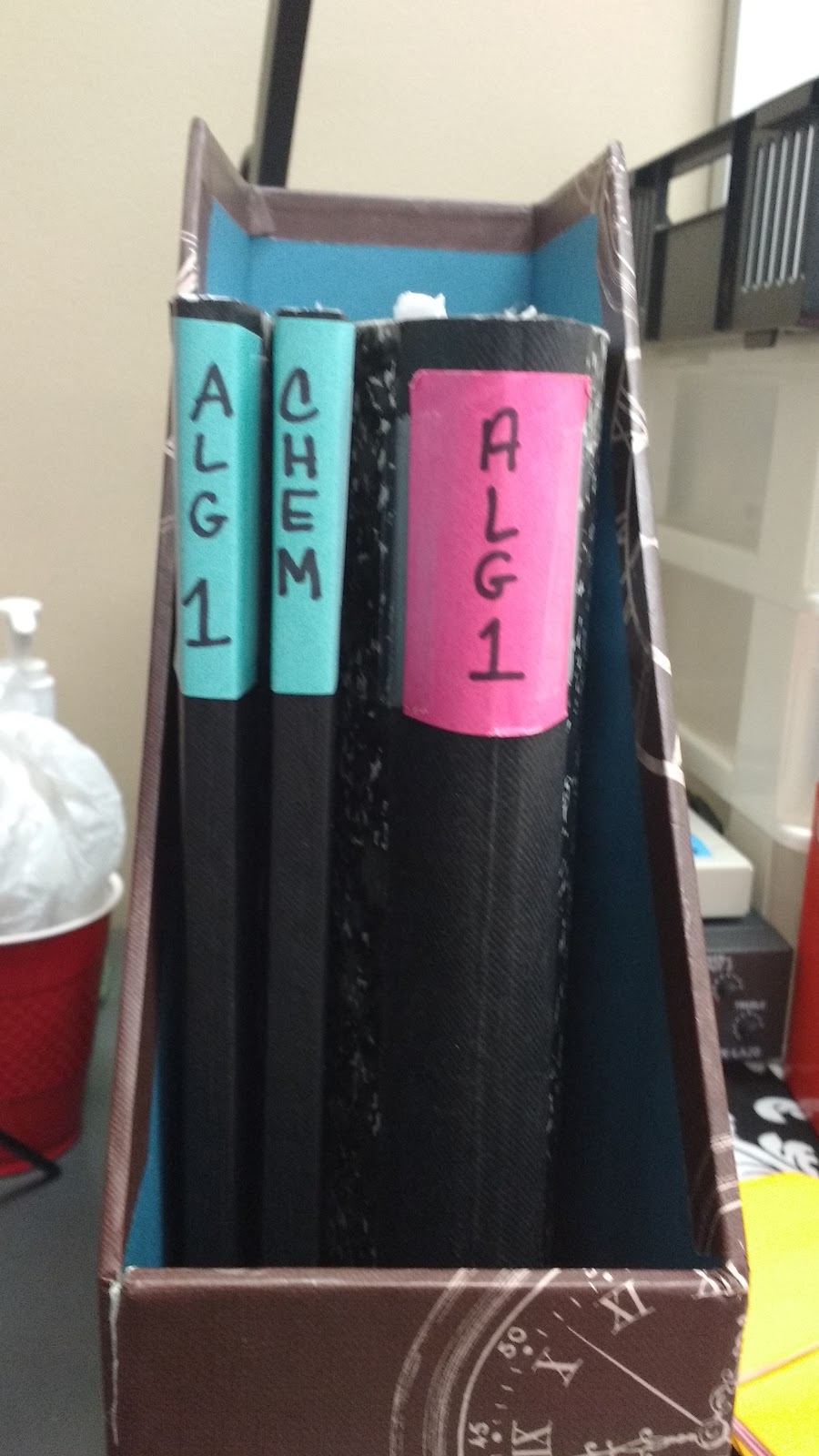
Speaking of notebooks, I made a tiny tweak to how I do notebooks, and it has been AWESOME. Students who have had me in the past have verbally thanked me numerous times for this new addition to our notebooks. It’s a Temporary storage pocket formed by folding over a page in our notebooks and taping it to the previous page. When we don’t finish something before class ends, students can stick it in the temporary storage pocket instead of just stuffing it in their notebook or bag randomly to never be seen again. In a way, it is like a mini “inbox” for our notebooks. My students’ notebooks are so much more organized this year than ever before.
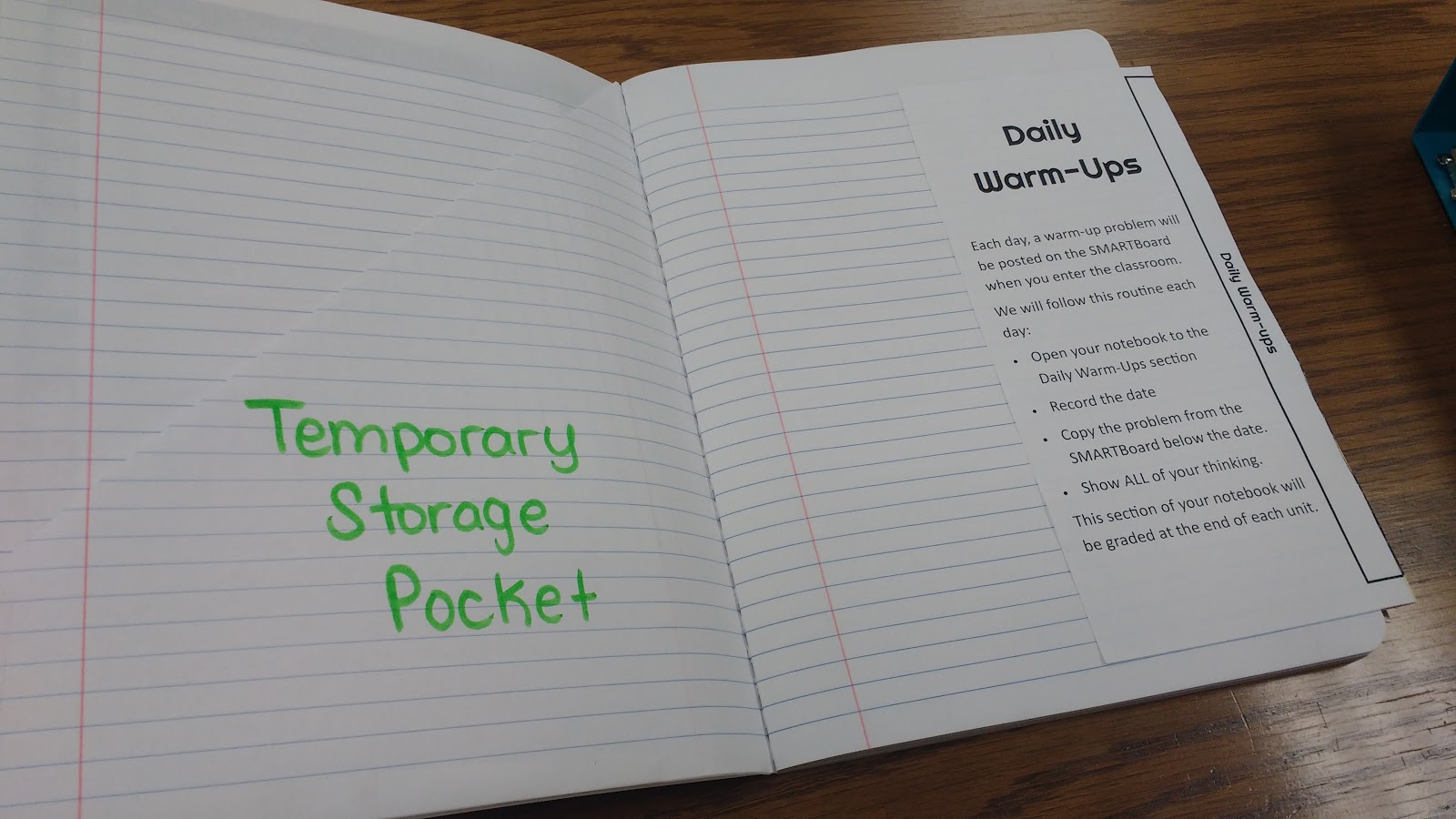
One thing that I love about Angela’s attitude toward classroom organization is to start with what you have. She doesn’t advise going out and spending a bunch of money on supplies to get organized. Instead, she recommends re-purposing your current organization tools to meet your
actual needs.
Before I started my first year of teaching, I ran across a multi-drawer pink cart at a garage sale for $5. I excitedly bought it and stuck it in the corner of my classroom. I put notebook paper in the first drawer, graph paper in the second drawer, origami paper in the third drawer, Frayer Models in the fourth drawer, and a no-longer used version of interactive notebook table of contents in the fifth drawer. The other five drawers set empty because I had no clue what to use them for. And, they stayed empty for FIVE years.
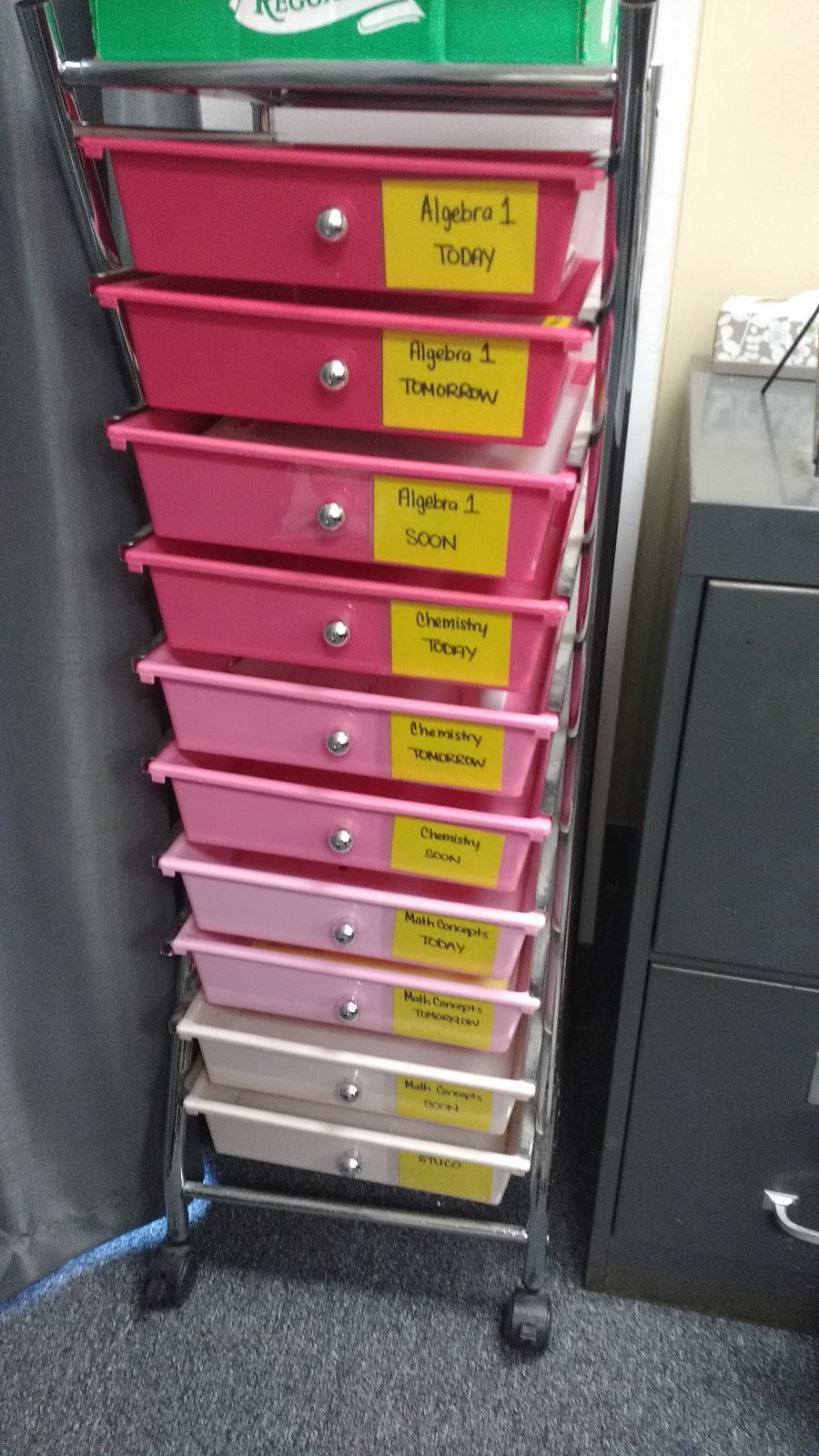
I was starting to wonder if it was even worth keeping this 10 drawer car since I was barely utilizing it. When Angela started encouraging us club members to examine what organization tools we already had, I knew that this pink cart HAD to be repurposed into something I actually use.
I found a new home for the papers that my students frequently need to use. There were only three types of paper I wanted to have out for them to use, so there was no reason to store them in a cart that held three times that amount.

Then, I relabeled my drawers in such a way that would help me sort my copies and activities for each class. I have three preps, so I dedicated three drawers to each prep. For Algebra 1, I have a drawer that says TODAY, a drawer that says TOMORROW, and a drawer that says SOON. I have the same three drawers for Chemistry and Math Concepts. I am the sponsor for Student Council, so I have designated my final drawer to hold STUCO materials. When I make my copies for the entire week (something I never could have done before joining Angela’s club), I can file them away easily so that I can find them later. I can’t tell you how many times in the past I’ve had to reprint a set of copies because I’ve misplaced them on my desk. No more misplaced papers with
this system!
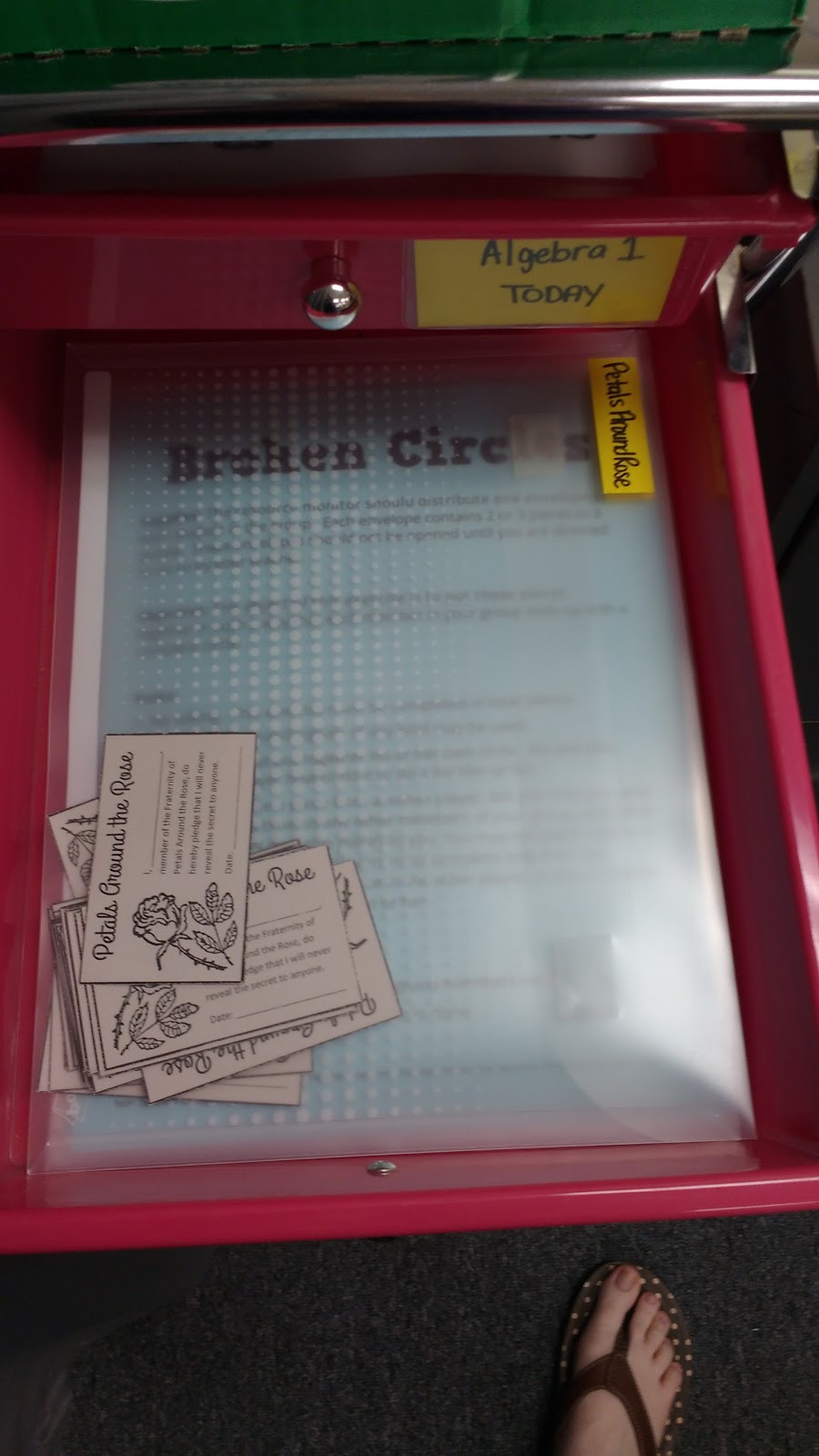
When the day is over, I take a few minutes to put all of the day’s materials in their appropriate places. If it is a notebook page or worksheet that absent students will need to pick up, I place the extra copies in my hanging files.

Each folder is labeled with a different SBG Skill Code. I feel like I really upped my organization game this year by labeling all of my folders BEFORE the school year started instead of waiting until we did each skill to label a folder like in years past. I used removable labels If I decide to change up my skill codes next year, I can easily remove this years labels.
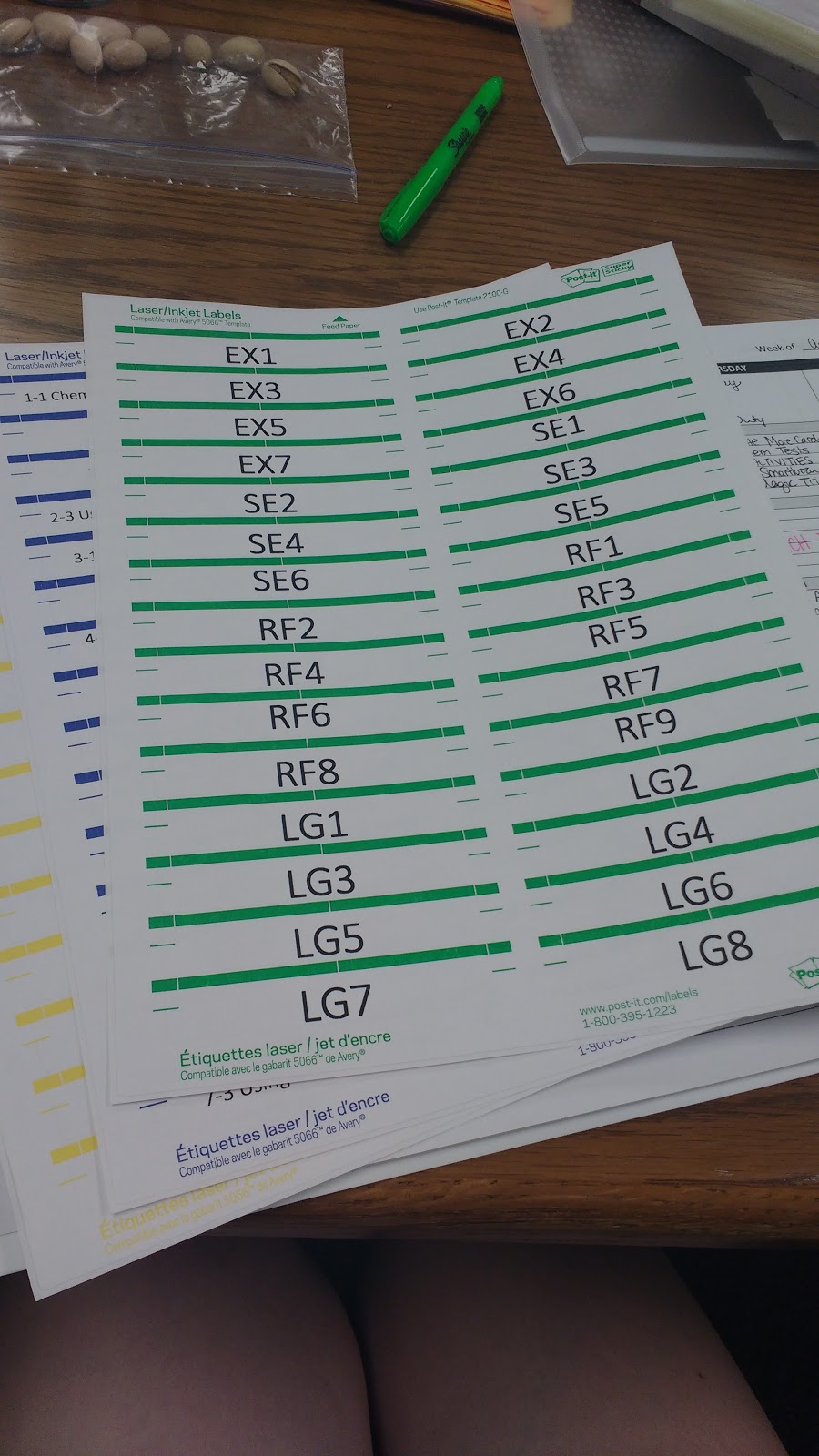
I did the same thing for my chemistry class, but I chose to use textbook sections instead of SBG skills since I am not using SBG with my chemistry class this year. I really debated this over the summer because I believe that SBG is better than the traditional grading system. I also believe that my sanity is worth something, though. I don’t know enough chemistry yet to be able to write my own curriculum. So, I chose to do what was best for my students and my work/life balance this year. This meant following a textbook.
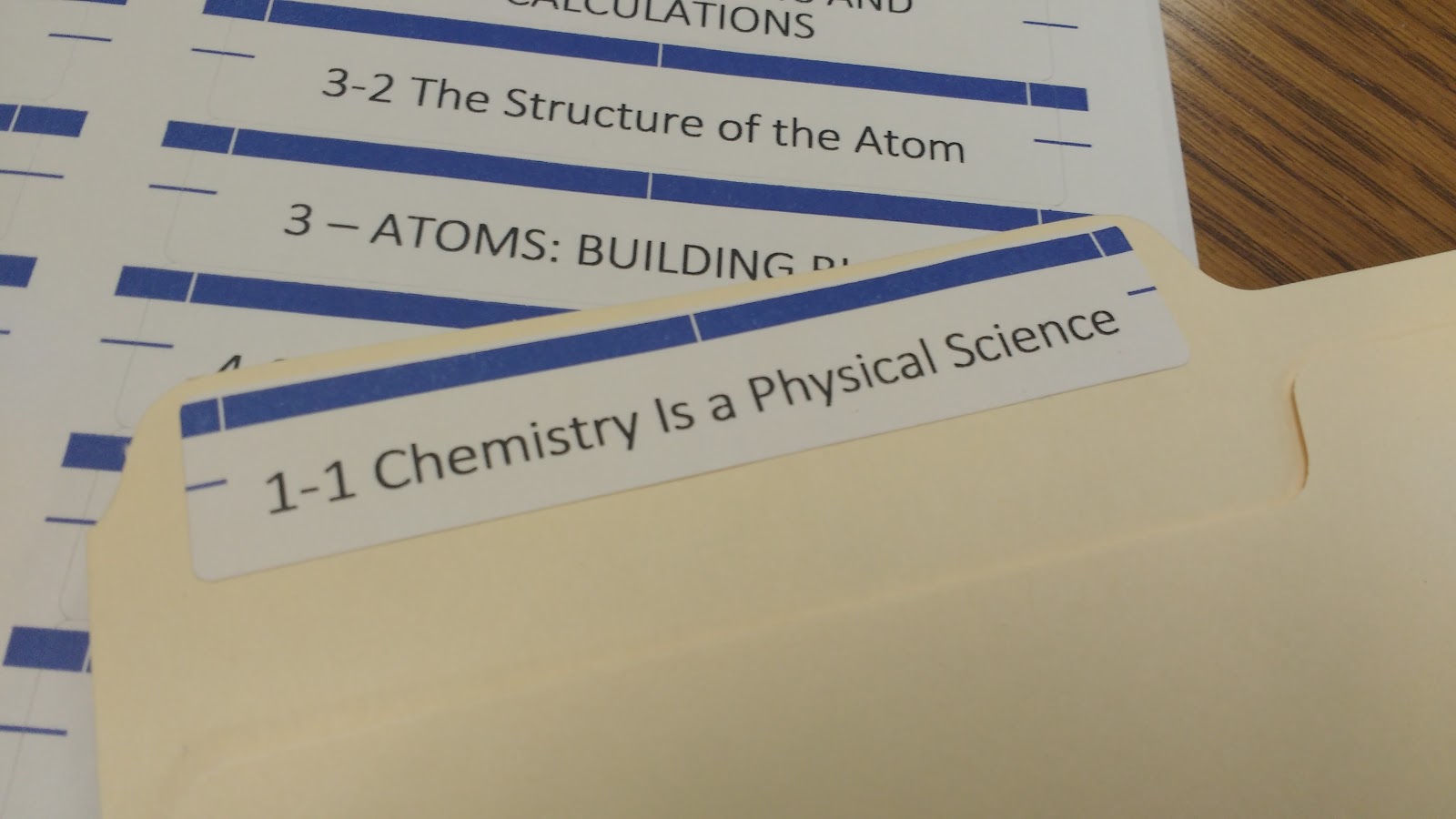
If it is an activity that I plan on reusing in the future, it gets filed alphabetically in a plastic storage pocket in my filing cabinet.

I’ve also re-organized the file drawer in my desk to hold all of my quiz copies. Because I do standards based grading, my students are frequently asking to retake an old quiz. My students are regularly amazed at how quickly I can find the quiz they need in my desk. One student told me the other day that I was the “most organized teacher [they] had ever had.” Previous year’s students would NEVER have said this about me. I printed a second set of my file folder labels that I mentioned above to label the folders in my quiz drawer.
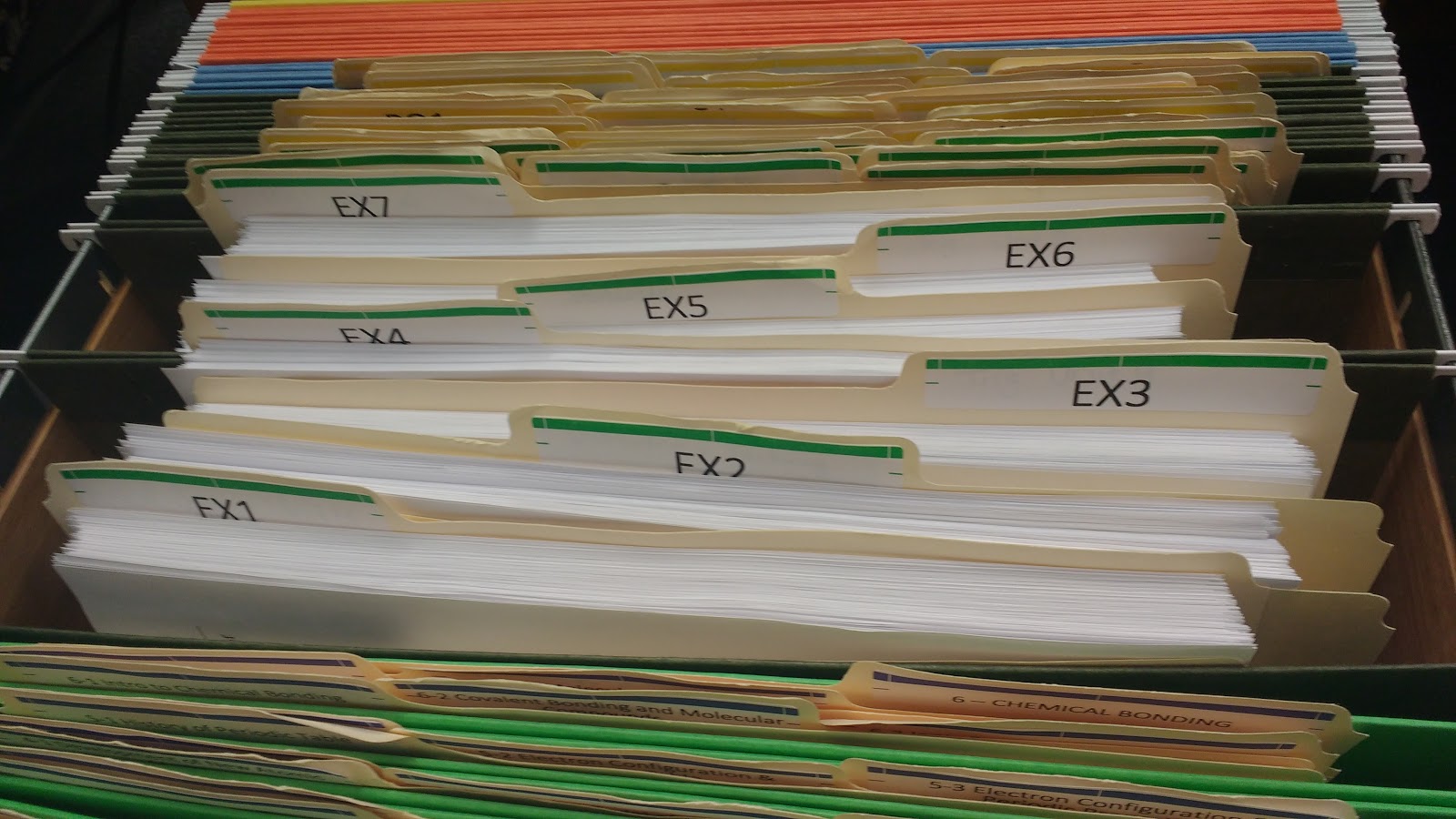
Classroom decorating was super easy this year because I took a bit of time at the end of last year to organize all of the posters I have made for my classroom over the years. Each set of posters is stored in a plastic storage pocket and labeled with a super sticky post-it label. These are then stored alphabetically in a small filing cabinet that sits by my desk.
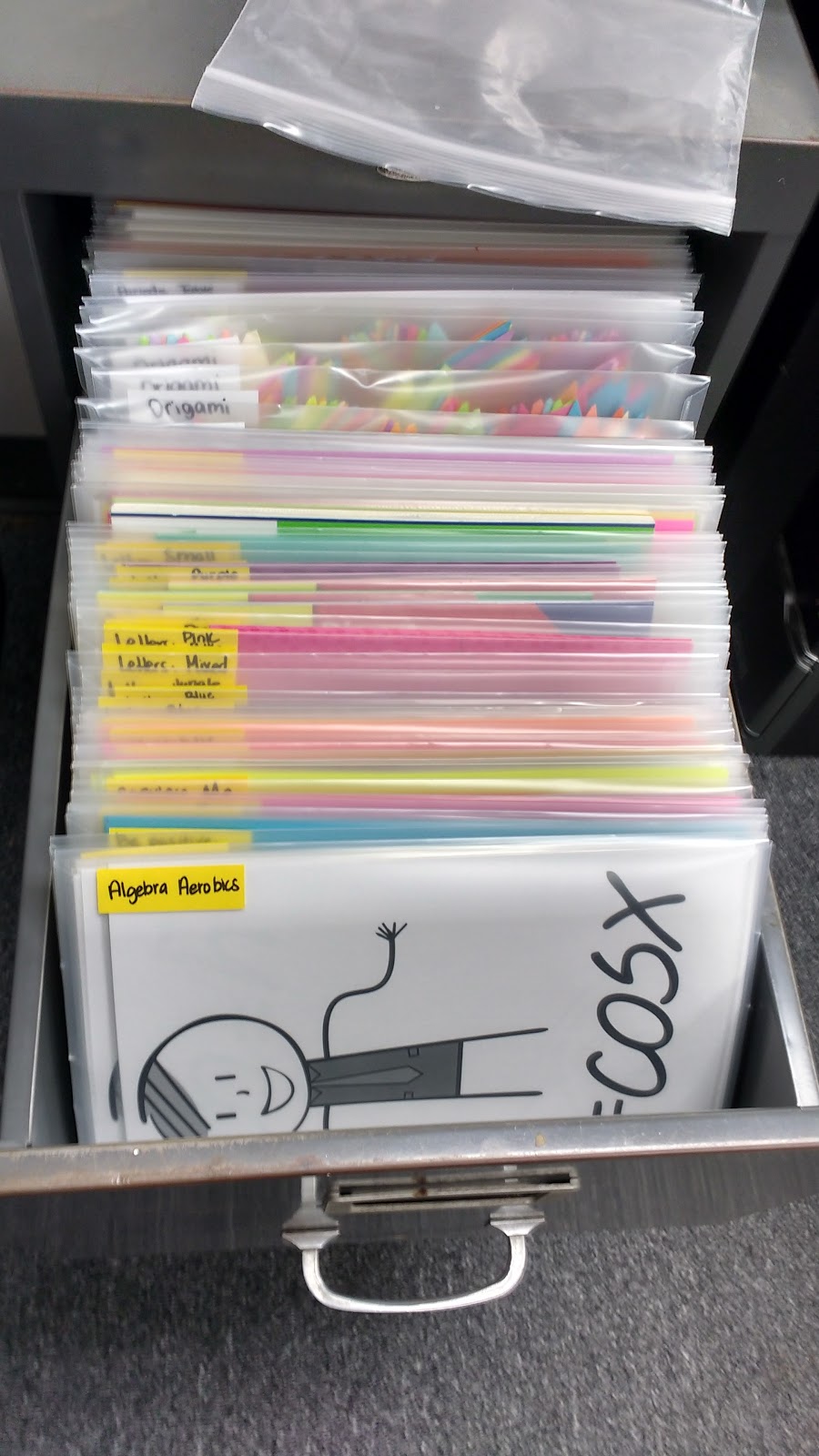
Perhaps the biggest change I’ve made since joining the 40 Hour Teacher Workweek is actually utilizing my teacher planner! I use the Staples Arc System. To help myself better utilize the 40 Hour Teacher Work Week List Making System which you will receive as a free bonus for joining the club, I splurged and bought a new Arc notebook cover and set of rings. My husband and I invested in an Arc Punch a couple of years ago, and it has definitely paid for itself already.

My notebook is what lets me function effectively as a teacher. Here it is in its assembled glory.
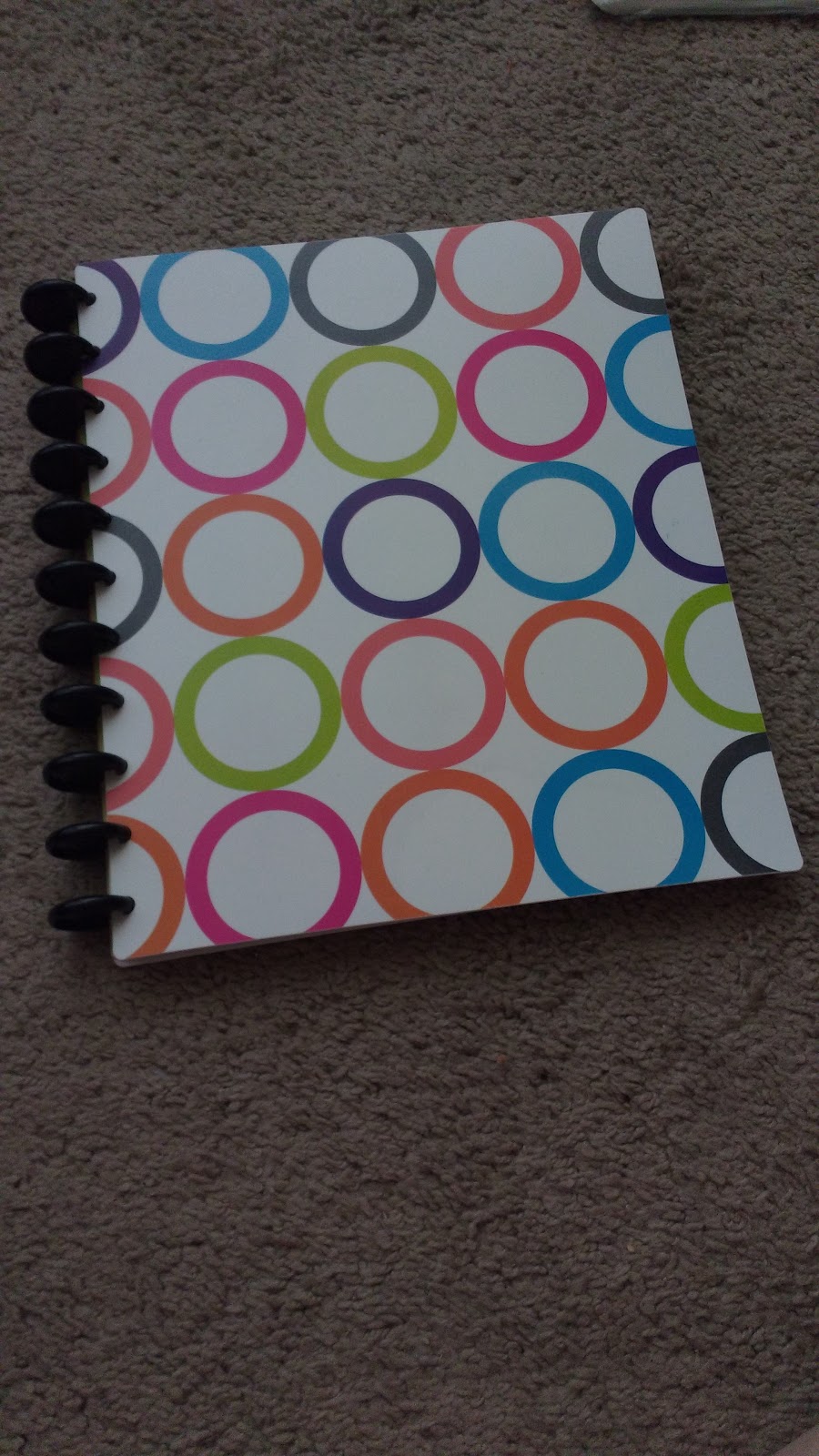
I have dividers inside to help me keep things separate and organized.
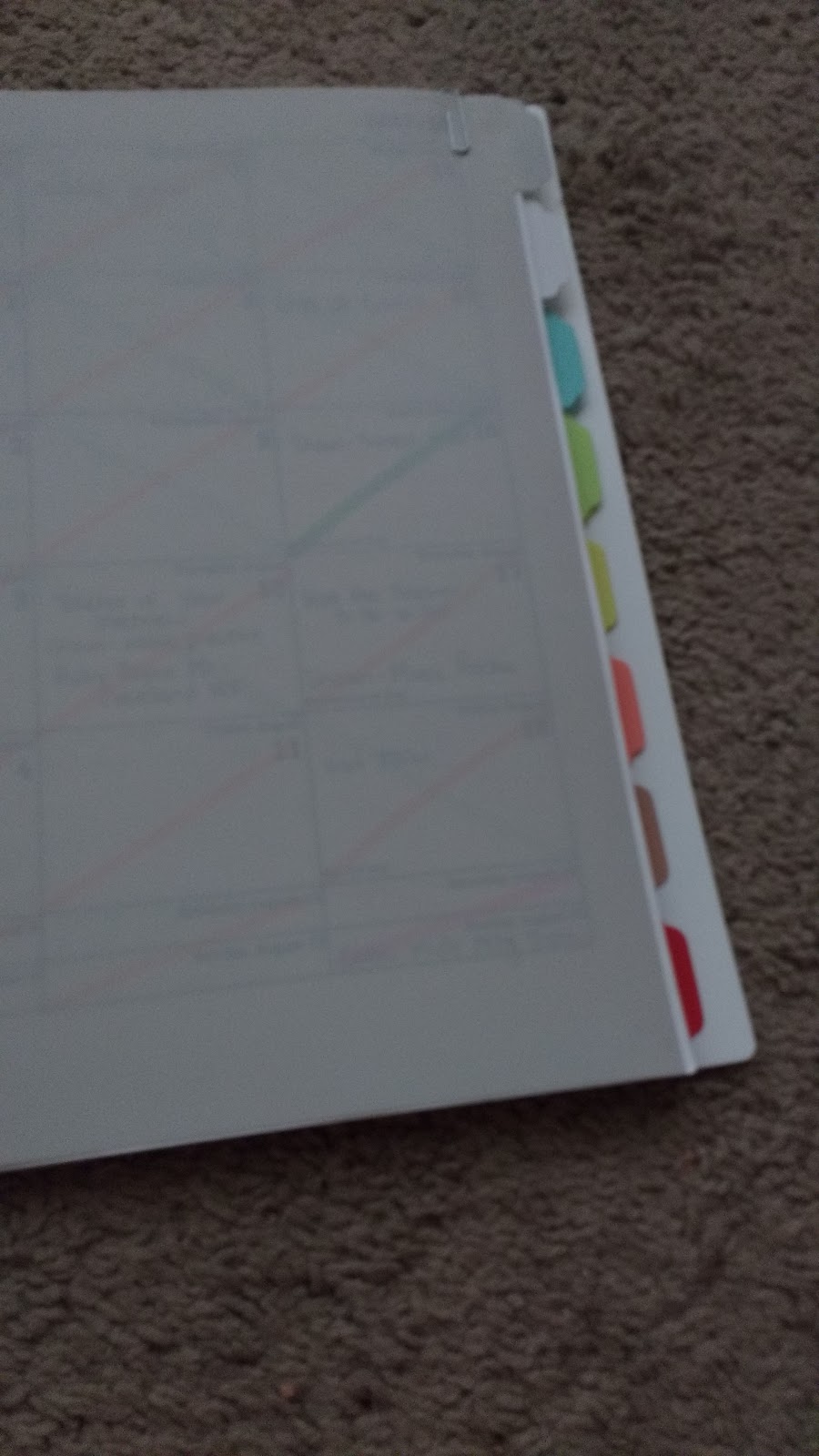
My first divider holds my calendar. Angela suggests keeping your calendar separate from your to do list. This has made a HUGE difference for me this year. In the past, I tried to combine them, and it made things a lot more complicated. My initial plan was to create a monthly calendar with large boxes, but I became frustrated by how much space was wasted on the page due to the fact that the months started on different days and had different numbers of weeks. My husband created this continuous calendar template (and shared it for free on his blog) that is PERFECT for me.
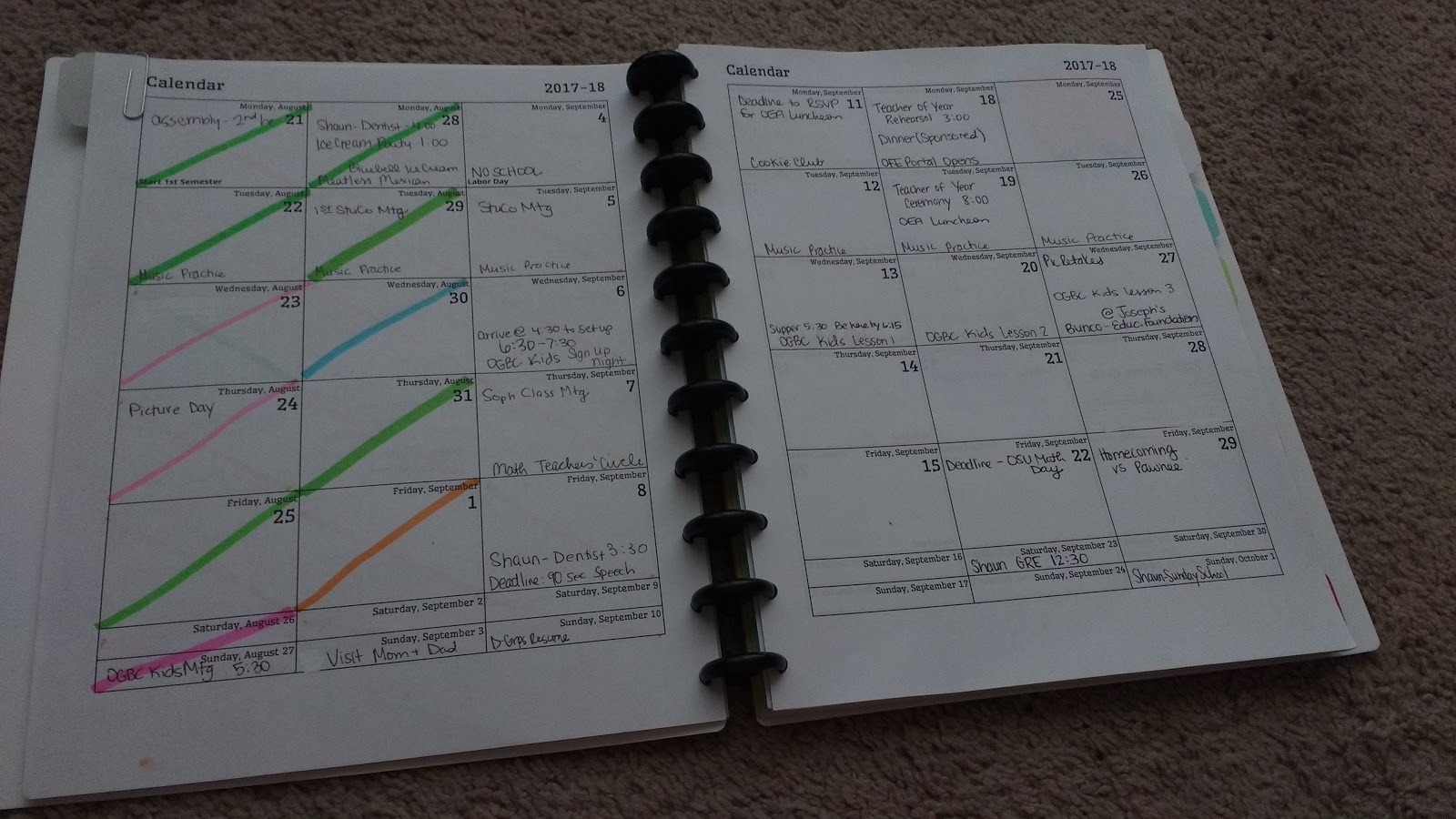
Angela suggests putting a mark through each day as it is finished. I didn’t think I would love this act as much as I do. It is such a fulfilling feeling to mark a day as done.
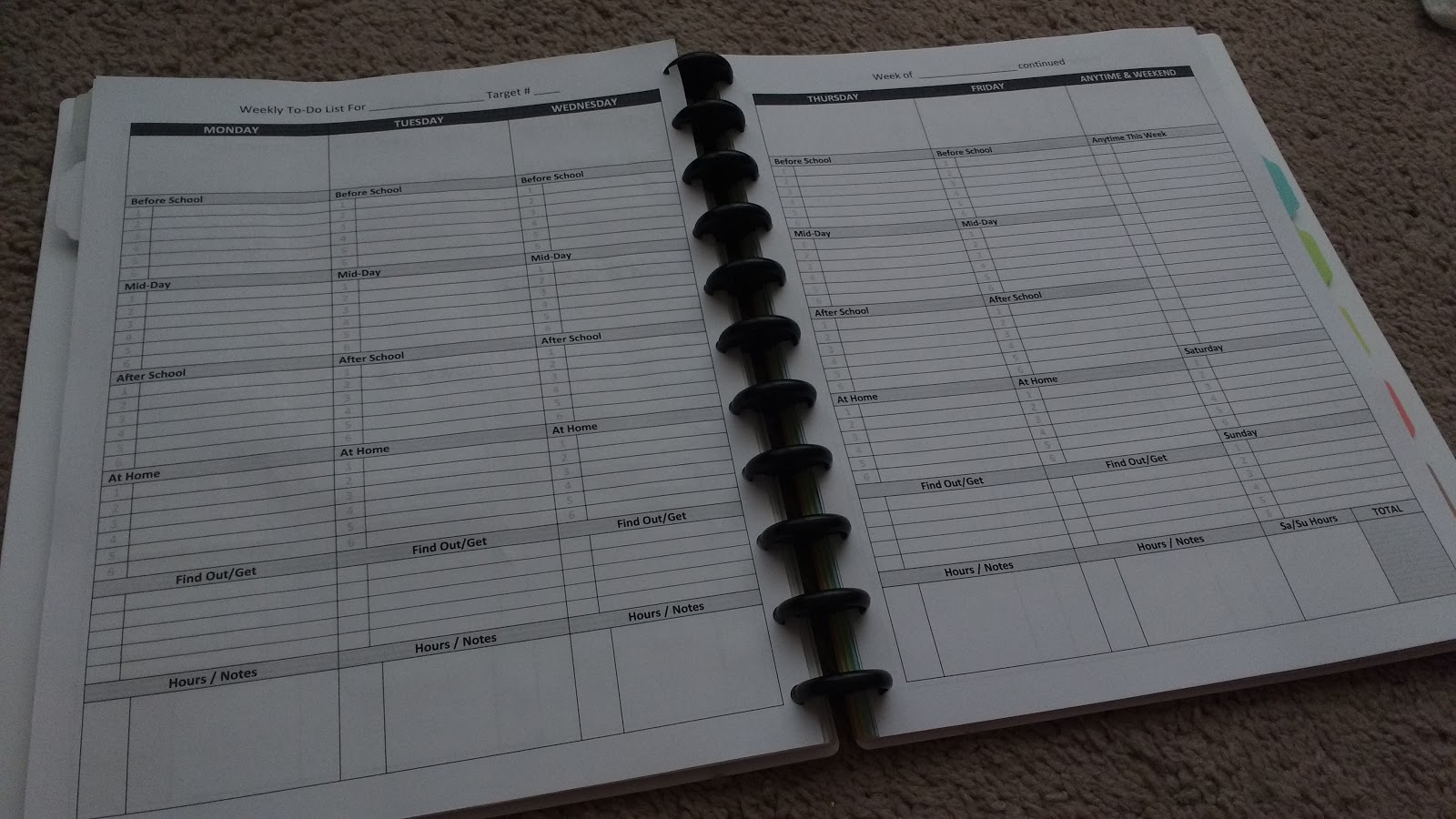
The next divider holds my weekly to do lists that are based on the 40 Hour Teacher Workweek
List Making System. When you join the club, you will get access to all kinds of helpful printables to keep yourself organized. I love that Angela offers everything as a pretty PDF and as an editable version (usually WORD) so you can tweak things to work perfectly for your own situation.
In fact, I’ve edited the template several times since I took the photo above. I keep figuring out ways to make it work better for me. This is one reason I adore the Arc System for keeping a planner. I can change out the pages whenever I feel like it.
In my other dividers, I have Project Planning Sheets (provided by Angela), Long Term Planning Sheets (also provided by Angela), Seating Charts, and Lesson Plans.
Lesson Planning has probably been the area I’ve improved the most in since joining the 40 Hour Teacher Workweek Club. My first principal said that we had to write lesson plans and turn them in each week. I skipped turning them in one week, and my principal never said a word. So, I stopped writing them. I still planned out my lessons (usually on a post-it note), and I never got in trouble for it. Therefore, I never saw the reason to write out more formal lesson plans again.
Last summer, I was doing some serious thinking about my pacing for Algebra 1. Even though I’ve taught the course for a full five years (not counting this year), I have no idea of how I’ve ever paced stuff in the past because I never wrote lesson plans. This was when I realized that I could make my lesson plans into a resource for me instead of just something I turn into my principal.
If you’re required to turn in formal lesson plans, this approach probably won’t work for you. But, it’s perfect for me.
I created a blank weekly lesson plan template. It has space for the date, the planned activities, and notes about how those activities went. If you’ll look closely, you will see that the notes column is the widest. This is by design. I’m not keeping lesson plans to fulfill some administrative requirement. I’m keeping lesson plans so I can look back at them in the future and learn from my past experiences.
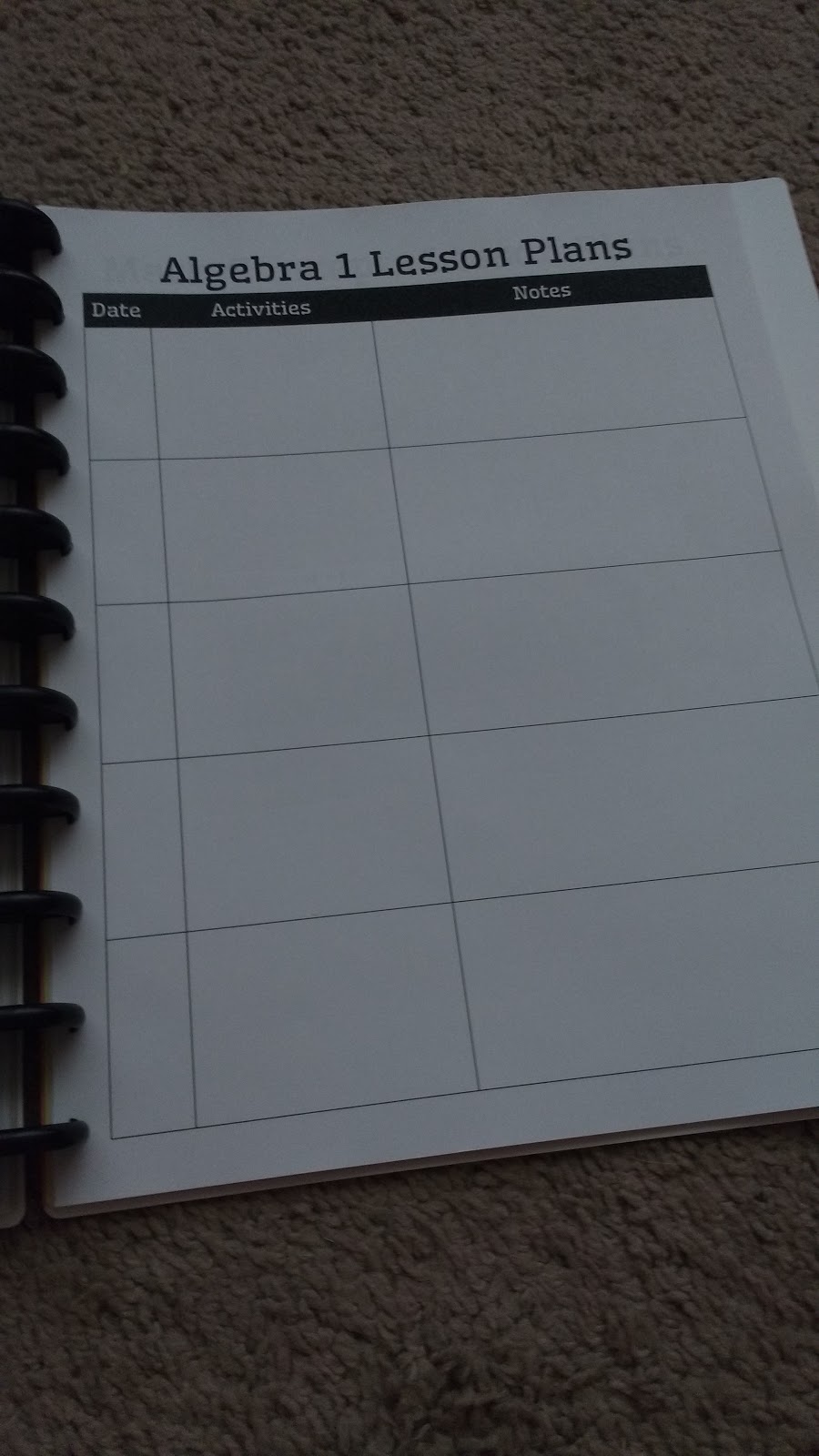
Every Friday, I take a bit of time during my planning period and write out the future week’s planned activities on my lesson plan template. This usually doesn’t take more than ten or so minutes.
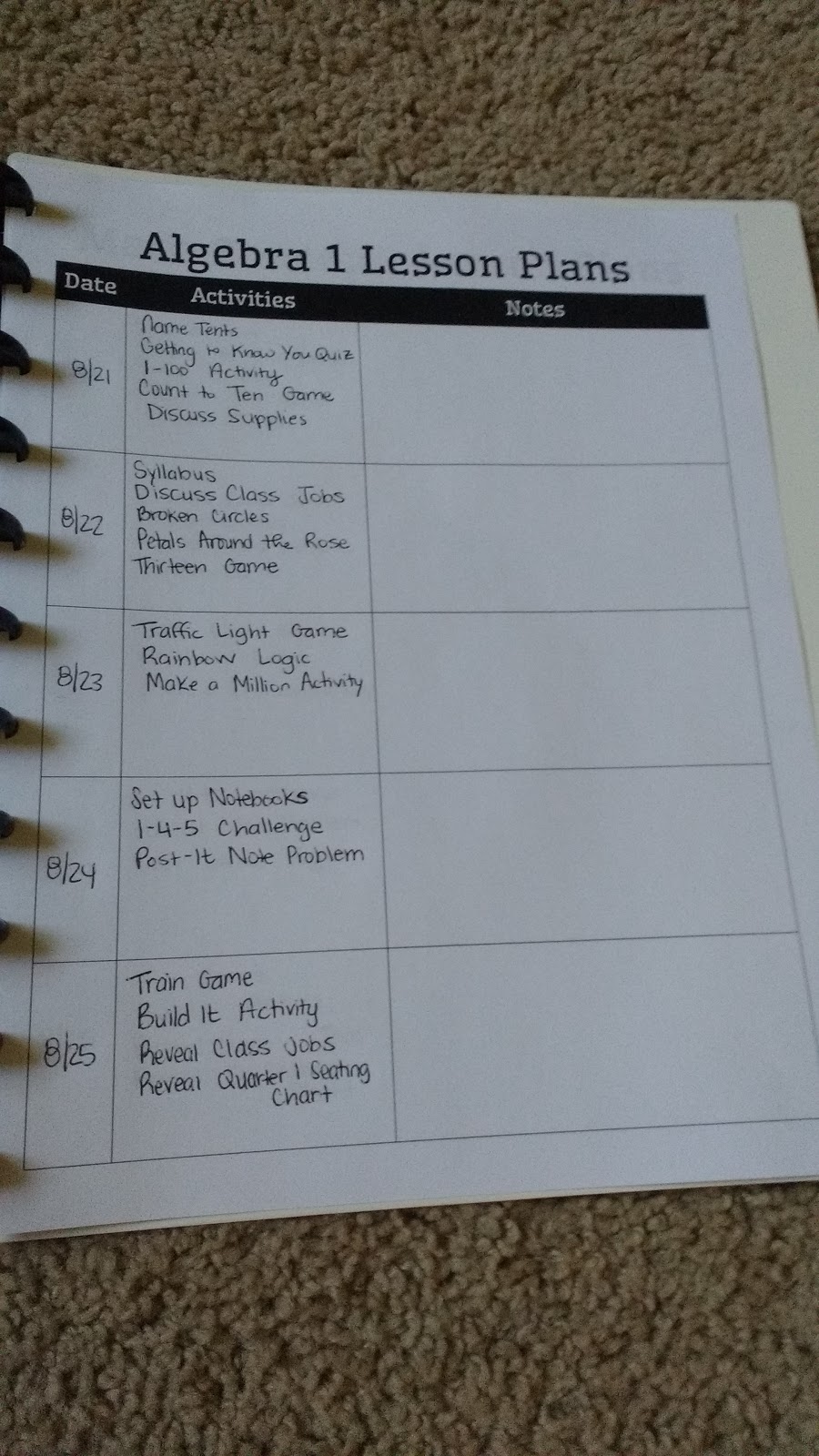
I have last period plan, so I have a recurring item on my to-do list everyday for my planning period. If you looked at my to-do list, you would see the words “Update Lesson Plans.” Each day uses a different colored highlighter. I highlight the date, and then I highlight the activities we ACTUALLY accomplished that day. Often things come up or things take longer than I planned, and we don’t end up accomplishing everything I had planned. Finally, I fill in the Notes Column with what went well/what didn’t go well. I make note of how long various activities took. And, I write suggested changes for the future.
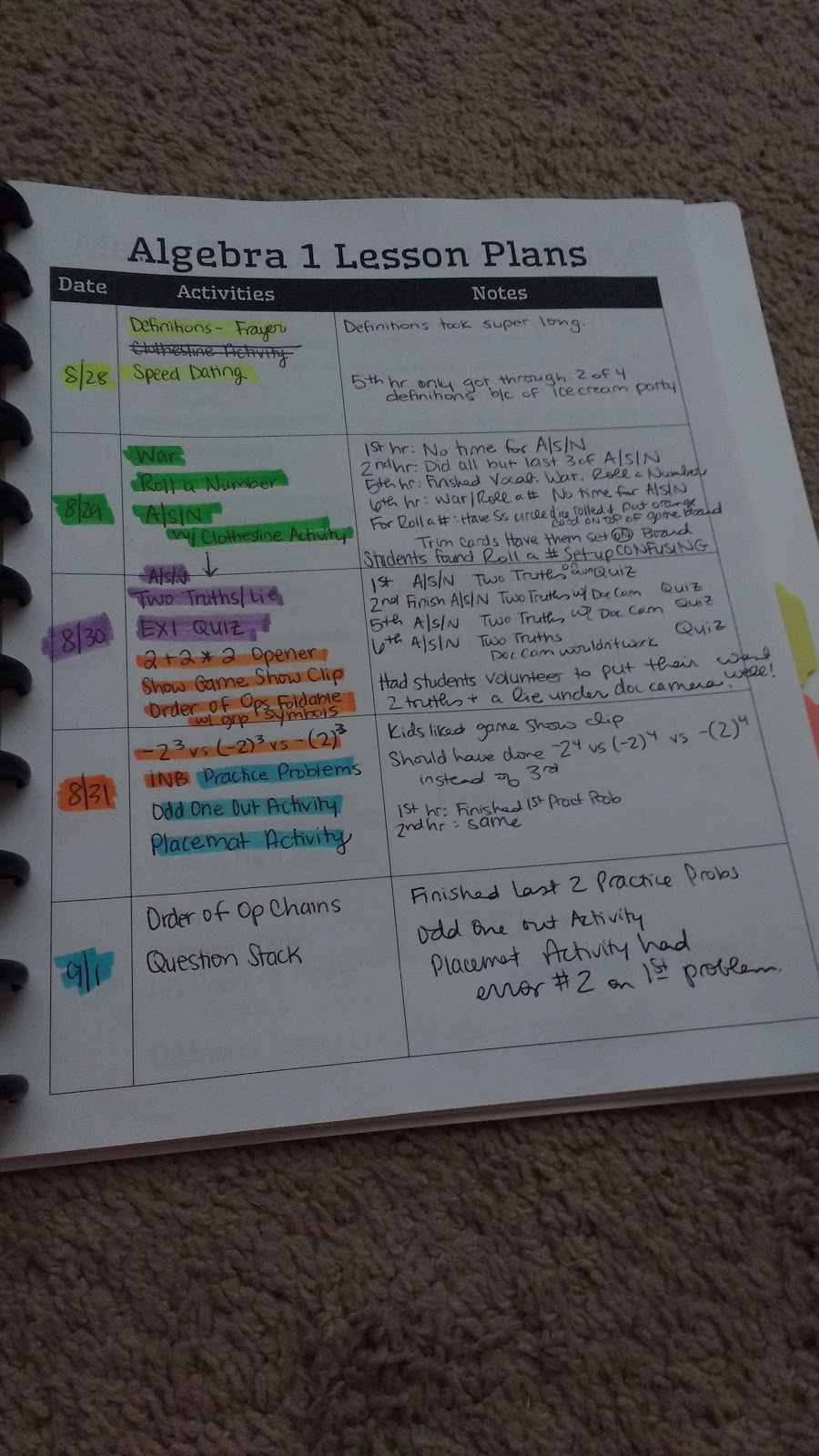
I love this approach to lesson planning because it embraces the messiness that naturally comes with teaching. I teach students, not robots; therefore, I have to be flexible. Some days I move on to the next day’s topic a day early because an activity took way less time than I had budgeted for it. Other days, I find myself a day or two behind because of the opposite problem.
Lesson plans used to frustrate me because the plans I turned into my principal usually looked nothing like what I actually ended up teaching on each day. Now, my lesson planning has wiggle room, and it actually works. After an entire semester of using this approach, I successfully lesson planned for all but two weeks of it. I got sick and behind and never got caught up. But, that’s okay. Angela reminds us frequently that we all grow inconsistently. I am not defined by my setbacks but by my progress. For the first time in my teaching career, I look forward to lesson planning.
The 40 Hour Teacher Workweek Club isn’t a prescribed plan that tells you to do X, Y, and Z. It’s a
program that helps you to think critically about the way you run your classroom and to make improvements that work for you and your students. It offers a continual reminder that teaching is difficult. And, it offers helpful hints to making your classroom run smoother so you have a chance to achieve that work/life balance that often seems impossible. Angela’s encouragement each week is genuine, and she shares tips she actually used in her own classroom when she was a teacher. I love hearing what worked and didn’t work for her and brainstorming ways to improve my own teaching and classroom management.
I think I’ve said this before, but I’ll say it again. You are going to get out of the club what you put in the club. If you enter this club with the mindset of wanting to look critically at how you run your classroom and with a willingness to try new things, your hard work will pay off with great dividends. This club has made me try new classroom strategies (such as embracing the idea of classroom jobs) that I never would have considered before. And, guess what?!? They work. I can’t imagine ever teaching without classroom jobs again.
Remember, if you do decide to take the plunge and sign up, I would appreciate it if you listed me as referring you. You’ll enter my name (Sarah Carter) and my email mathequalslove@gmail.com when you sign up.
Whether you decide to join or not, I hope you have enjoyed this peek into my teaching life and the changes I’ve made recently. Angela Watson ends each week’s audio with this advice: “Small changes really do add up to big results.” And, this is definitely true. Each thing I’ve mentioned in these recent posts have been a small change. But, together, they have changed my teaching career for the better.

Sarah – I signed up! I too have three different classes this year, and I am less organized than ever. Can you share a link to the bins you are using for students to turn in their work?
Sarah, I'm so impressed at your honesty! From the outside, it certainly didn't look like you were struggling last year. I think a lot of teachers suffer from the internal doubts you wrote about. That's fantastic that the club is working so well for you – it's such a good idea of how to support teachers and reduce the number of people leaving the profession after a few years.
Thank you for sharing this! I have looked into Angela Watson's stuff since you first mentioned it on Twitter maybe? I wondered if this is something I would like or what kinds of advice she gives, so I appreciate your preview in helping me decide if the club would be useful for me. I actually forced myself to do these things about this time last year before I even heard of Angela Watson. I finally decided that I wanted to be completely present at school and completely present at home and not let the two overlap so much. I forced myself not to take work home, and that forced me to start being more efficient during the day. Sometimes I feel guilty about the time I'm not putting in after hours any more, but I'm so much happier with my work life now and my work/life balance! I'm much further away from burnout. You are so talented, that I'm thankful you discovered how to make the balance work for you too before you burned out. Keep up the good work!
As a club graduate, I found your post interesting. I just assumed that we all started at the same point no matter when we signed up. I started last January, and the January – May club materials were of very little use to me (aside from April), and it formed my perception of the club and I feel that I didn't get much out of it as a result. I really wish I joined in July instead. The summer is when things became more relevant to me. Also, will you post more about your class jobs? I tried to implement them this year, and I had very little buy-in from my students. I only have 2 students that actually took jobs.
What are you using to hold the clipboards to the whiteboard?
No name papers. Ugh
I bought a 20" sign with clips at the bottom at target that says 'this belongs to' it is attached by 2 nails to some wood piece in my room. I clip the papers and toss them every 2 weeks. Less space. My board space is premium real estate.